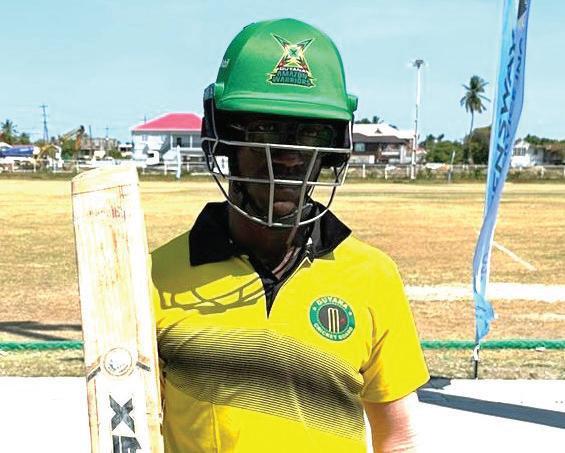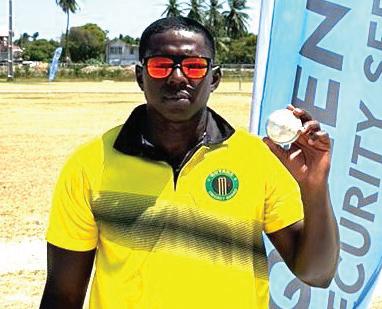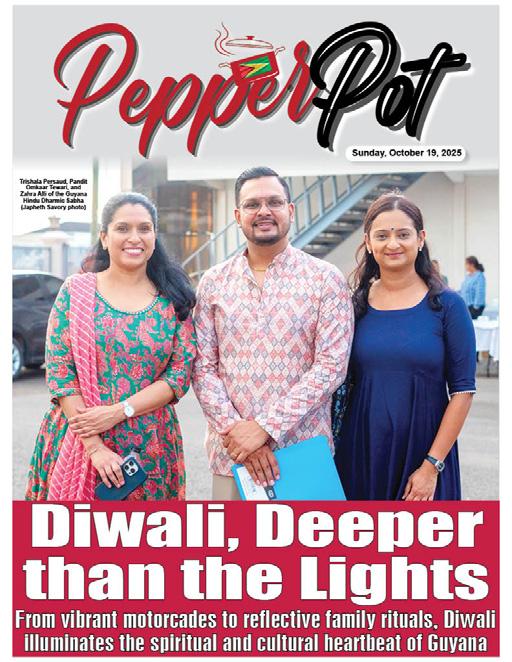



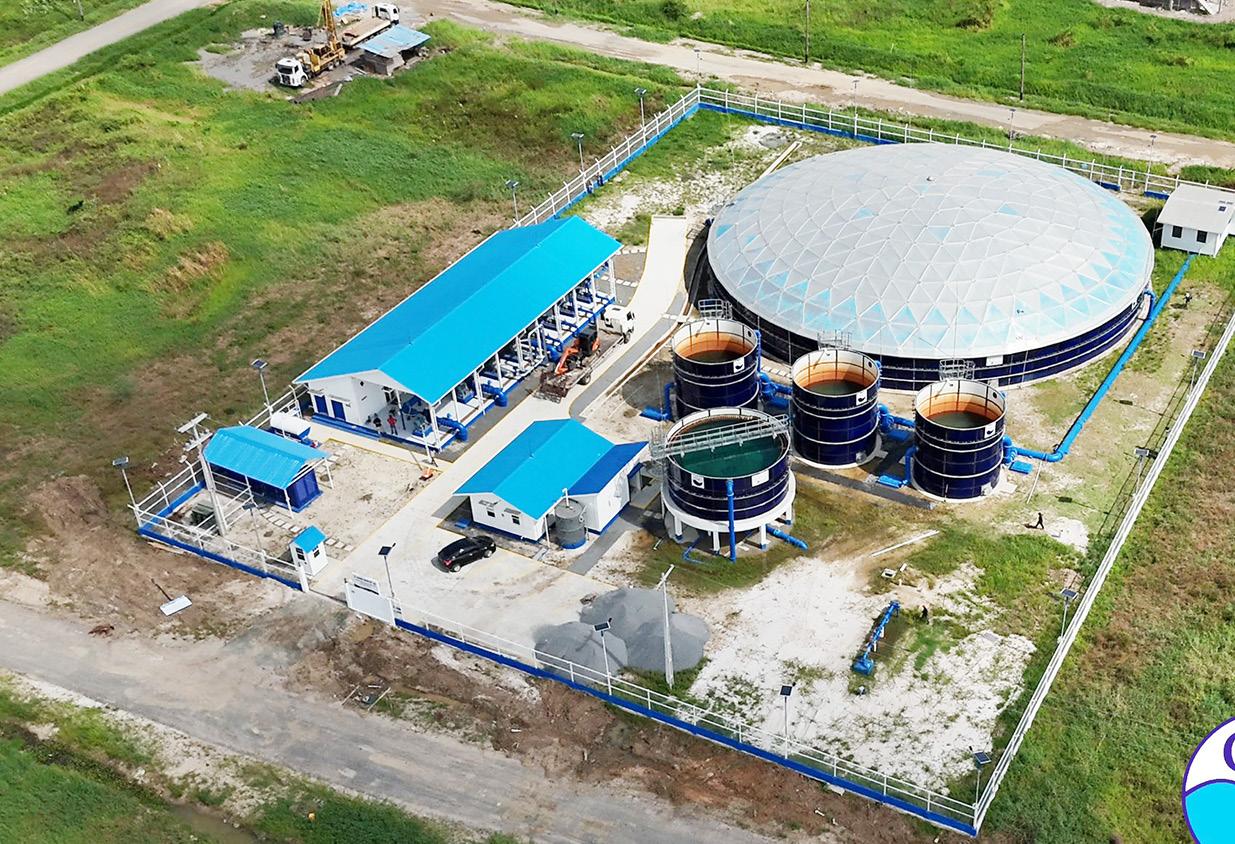
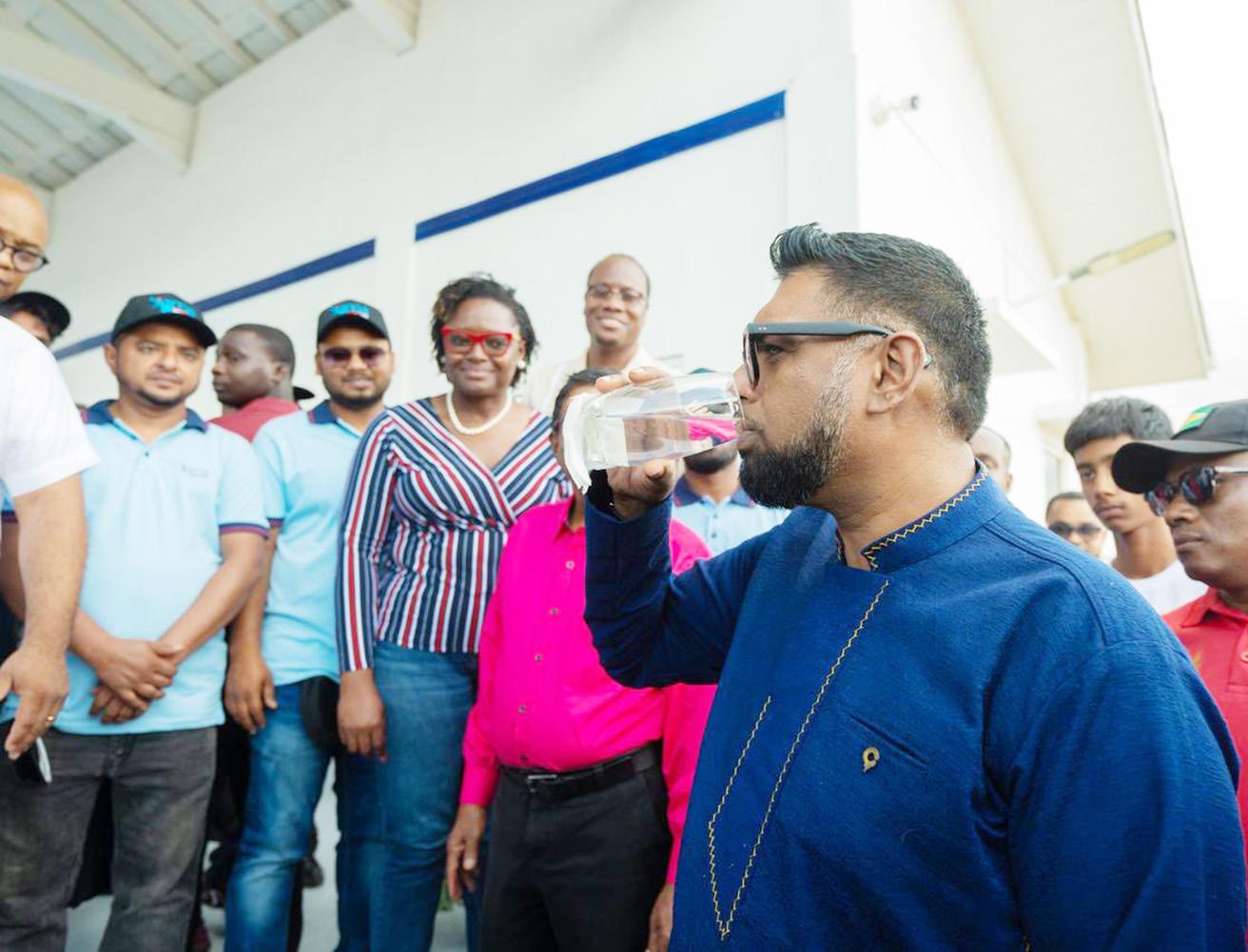











By Feona Morrison
PRESIDENT Dr. Irfaan Ali on Saturday underscored that access to clean water is a basic human right, not a privilege, as he delivered the feature address at the commissioning of the $2.2 billion New Cummings Lodge Water Treatment Plant — the largest of its kind in Guyana.
Addressing government officials, engineers, and residents gathered at the site, President Ali said the project represents more than infrastructure.
“Today, I want to speak to you not so much about the technical specifications of this water plant. I want to talk to you about water,” he said. “Water is not just a utility; it is life itself. It keeps us and our children healthy, our farms fertile, and our industries alive. It is indispensable.”
He reminded citizens that while water may seem free,
a pillar of public health, and a driver of development. And your government has made those investments because we understand that access to clean water is not a privilege; it is a right.”
The president highlighted that national access to potable water has reached 98.4 per cent, one of the highest rates in the Caribbean, and in hinterland and riverine areas, access has doubled to about 92 per cent, projected to rise to 96 per cent by next year.
“There are many countries in the developed world that would not invest in such small communities because it does not make economic sense,” he noted. “We invest because it makes human sense,” Dr. Ali stated.
The new Cummings Lodge facility, he explained, forms part of a wider national effort to ensure that every Guyanese, regardless of geography or income, has access to
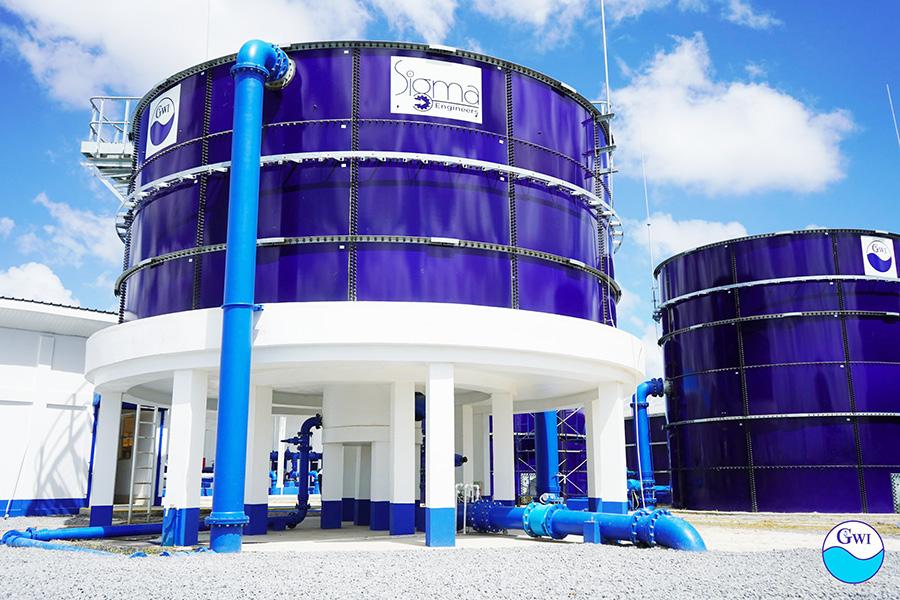
treated water is the product of massive investment, skilled work, and careful planning. “Some people may ask, why such a massive investment? Isn’t water supposed to be free?” he recalled, sharing an anecdote about former President Dr. Cheddi Jagan’s response to a similar question.
“Dr. Jagan said, ‘Yes, God gives us rain, but we still have to install pipelines, treat the water, and maintain the systems that carry it safely into your homes.’”
Ali continued, “While rainwater is free, potable water is not. It is a product of planning, technology, and billions in investment.”
He noted that the government has spent more than $51 billion in capital works over the past five years to improve water infrastructure, equivalent to roughly $69,000 per citizen.
“Your government continues to subsidise water for you… not because it is cheap, but because it is essential,” he said. “Water is not just a commodity; it is a public good, the foundation for life,
our future.”
He further emphasised that clean water brings dignity and equality. “Development is not measured only by tall buildings or new highways, but by how clean our water is and how many people can access it,” Ali declared.
“When every Guyanese— from Lethem to Linden, from Mabaruma to Mahaica—can open a tap and receive clean, treated water, that is not just progress. That is equality in action. That is what it means to build One Guyana.”
The president concluded by reaffirming his administration’s commitment to universal access to potable water: “This government will never walk away from its duty to provide safe, reliable, and affordable water for all Guyanese.”
GWI IS ON THE MOVE Minister of Public Utilities and Aviation, Deodat Indar, reaffirmed the government’s
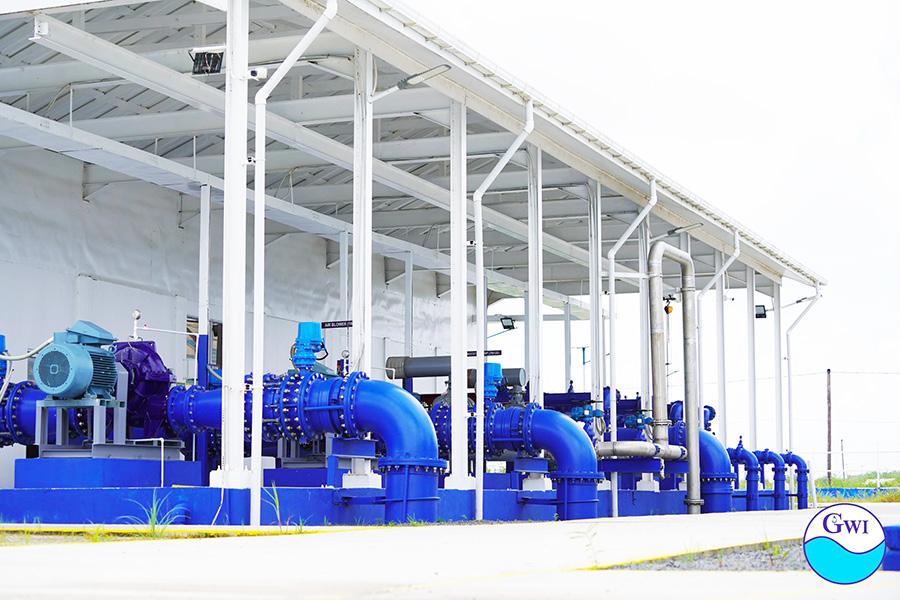
safe and reliable water.
“When you open your tap, remember this—you are not just seeing water. You’re seeing your government’s commitment, your taxes at work, your share of that $51 billion investment,” he said.
Dr. Ali also pointed to the government’s ongoing programme to improve water quality by reducing iron levels and transitioning from groundwater to cleaner surface sources.
He announced: “We have embarked on an ambitious programme to reduce iron levels and improve water quality with new surface water treatment plants coming at Hope Canal, Diamond, Grove, and Five Miles Bartica.”
Beyond infrastructure, he urged citizens to value and conserve water, warning that waste undermines the country’s progress. “Can we really afford to waste what costs billions of dollars to deliver?” he asked. “Every time a tap is left running, every leak we ignore—that is money flowing down the drain. When we conserve water, we conserve
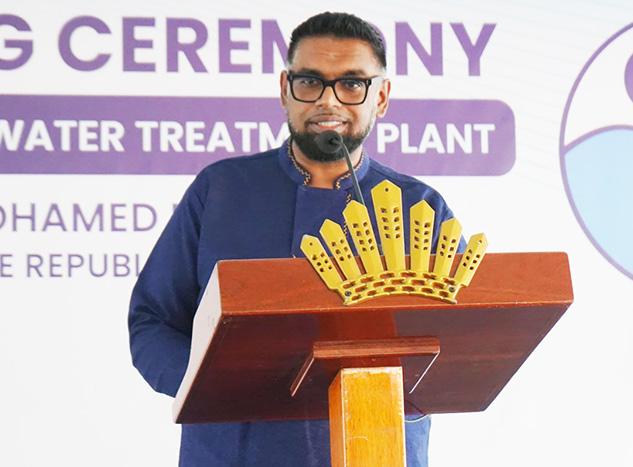
President has been able to come to all of these [commissioning ceremonies], showing his commitment to the water sector,” Baksh said.
He noted that the facility, built at a cost of $1.3 billion with additional infrastructure bringing the total investment to $2.2 billion, will serve communities including Cummings Lodge, Lamaha Springs, and
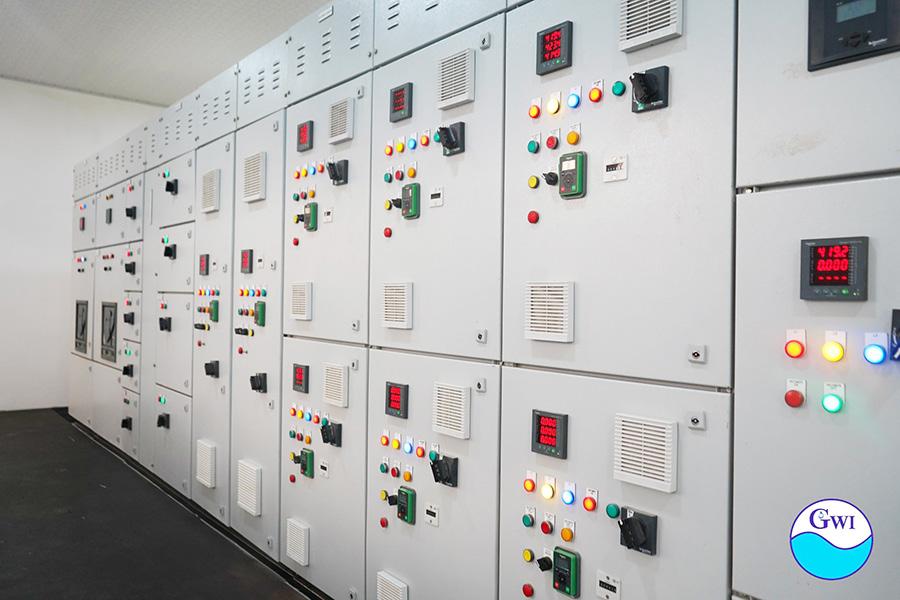
commitment to strengthening Guyana’s water infrastructure during the commissioning ceremony.
He said the plant “could only have been possible with the commitment and support of the Government of Guyana, and in particular our president, in providing much-needed investment for the water treatment programme.”
He also highlighted ongoing efforts, noting, “GWI is on the move, and I want to assure the public, with the government's support, that we will ensure a greater level of service and better quality of service to the population.”
Chief Executive Officer (CEO) of the Guyana Water Incorporated (GWI), Shaik Baksh, described the commissioning of the Cummings Lodge Water Treatment Plant as another milestone in the company’s efforts to expand access to treated water nationwide.
“This is the sixth treatment plant being commissioned, and I am very happy that the
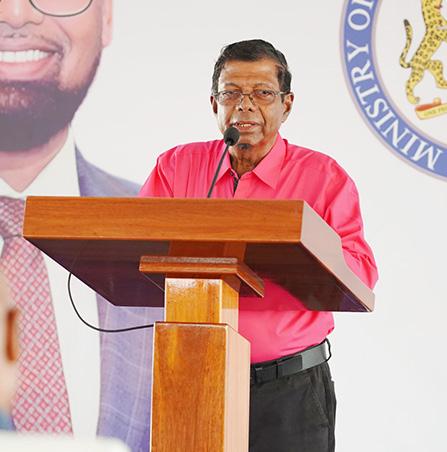
He highlighted that from 2021 to 2025, billions have been invested in the water sector, leading to 98.3 per cent national coverage.
“Our target is 100 per cent access,” Baksh affirmed, adding that GWI will continue to strengthen its maintenance, digital transformation, and hinterland water programmes to achieve that goal.
The plant is one of three new plants constructed in Region Four, the others being at Bachelor's Adventure and Caledonia. This stateof-the-art facility features a high-capacity design capable of treating 12 million litres per day (MLD), with a storage capacity of 3.6 million litres.
The plant is fully automated and controlled by a Supervisory Control and Data Acquisition (SCADA) system, which provides real-time monitoring and control over the entire treatment and distribution process.
Stevedore Housing Scheme. Baksh said the plant has the capacity to produce 12 million litres of water daily and can reach up to 15 million litres. “It is a state-of-the-art facility—fully automated, energy efficient, and equipped with high-efficiency booster pumps,” he stated.
To ensure a stable and reliable supply, the plant is also equipped with four highefficiency booster pumps for stable supply pressure to the distribution network. It was constructed by Sigma Engineers Ltd with a team comprising dozens of Guyanese staff.
Two additional wells are currently being drilled at the Cummings Lodge Water Treatment plant, which will provide raw water to be processed at the new facility.
Contracts valued at $600 million were also awarded and completed for the construction of 13.5 kilometres of new transmission mains to serve residents that aim to provide a high level of service and enhanced water quality.
The plant will serve over 10,000 residents from Cummings Lodge, Cummings Park, North Ruimveldt, South Ruimveldt Park, South Ruimveldt Gardens, Lamaha Springs, Lamaha Park, Festival City, Tucville, Stevedore, and along Heroes Highway.

GUYANA’S transport infrastructure is set for a major boost through the Integrated Transport Corridors Project (ITCP), following the signing of a US$156 million loan agreement between the Government of Guyana and the World Bank.
A press release from the Ministry of Finance noted that the agreement was signed by Senior Minister in the Office of the President with Responsibility for Finance Dr. Ashni Singh, and World Bank Vice- President for Latin America and the Caribbean Susana Cordeiro Guerra. The signing took place in Washington, D.C., on the margins of the 2025 World Bank Group/IMF Annual Meetings, held from October 13 to 18.
Approved earlier this
year by the World Bank’s Board of Executive Directors, the ITCP aims to support Guyana’s efforts to upgrade and rehabilitate critical road infrastructure. The project will focus on improving transport networks in selected regions to provide safer, more reliable, and climate-resilient road systems capable of withstanding natural hazards.
In brief remarks at the signing, Dr. Singh welcomed the World Bank’s continued partnership, noting that the ITCP “will make a tremendous contribution to the Government’s ongoing efforts to expand and upgrade the country’s transport networks”.
“This project has the potential to help unlock increased production and productivity in our non-oil economy, such as through

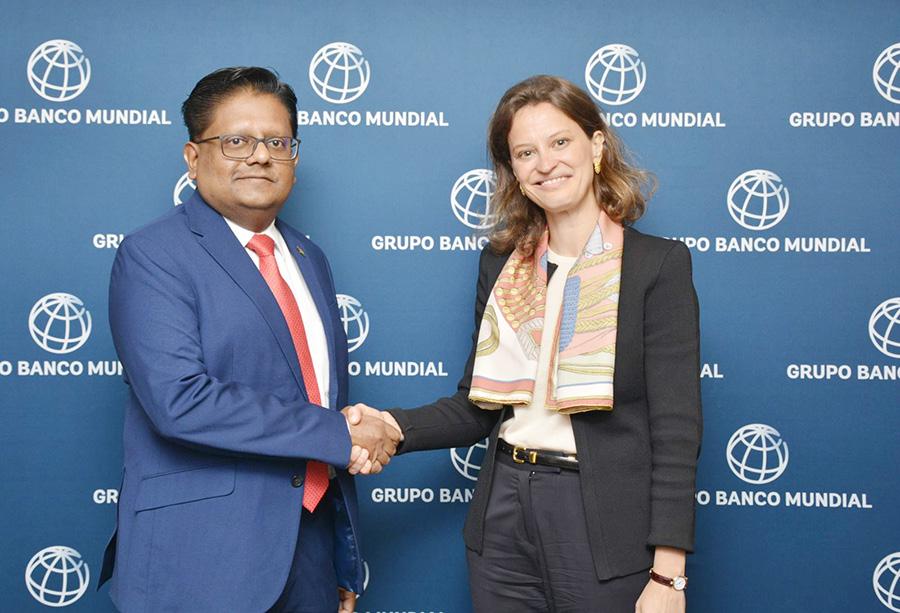
- Enhancing economic growth by enabling efficient movement of goods and people;
- Improving access to social services such as health and education; and
- Strengthening climate resilience through dedicated infrastructure solutions.
farm-to-market roads that facilitate both production and trade, as well as to improve connectivity between communities,” the minister underscored.
The ITCP aligns with Guyana’s national development goals, which include:
- Boosting agricul-
tural exports and food security by improving market access;
- Unlocking housing and tourism potential through better access to new development areas;
- Reducing traffic fatalities through improved road design and safety features;

According to the Ministry of Finance, the project forms part of the government’s broader agenda to modernise Guyana’s infrastructure, as outlined in the People’s Progressive Party/Civic (PPP/C)’s 2025–2030 Manifesto. The initiative is expected to generate significant economic and social returns, as the Irfaan Ali administration continues its drive towards rapid modernisation and economic expansion.
Over the past five years, the government has implemented some of the most transformative infrastructural projects in the country’s history, including new roads, bridges, and highways that have improved connectivity and eased travel for thousands
of Guyanese. Among the major initiatives underway or planned are the recently commissioned Demerara River Bridge linking Regions Three (Essequibo Islands-West Demerara) and Four (Demerara-Mahaica), the soon-to-commence Berbice River Bridge connecting Regions Five (Mahaica-Berbice) and Six (East Berbice-Corentyne), and the planned Corentyne River Bridge that will link Guyana with Suriname. Other projects include the continued upgrade of the Linden–Lethem Highway, the construction of bridges at Kurukupari and Puruni, the completion of the Soesdyke-Linden Highway upgrade, and a new four-lane highway along the East Bank of Demerara leading to the Cheddi Jagan International Airport. Through these projects, the government says it aims to unlock new economic opportunities, strengthen trade and connectivity, and improve the overall quality of life for all Guyanese.

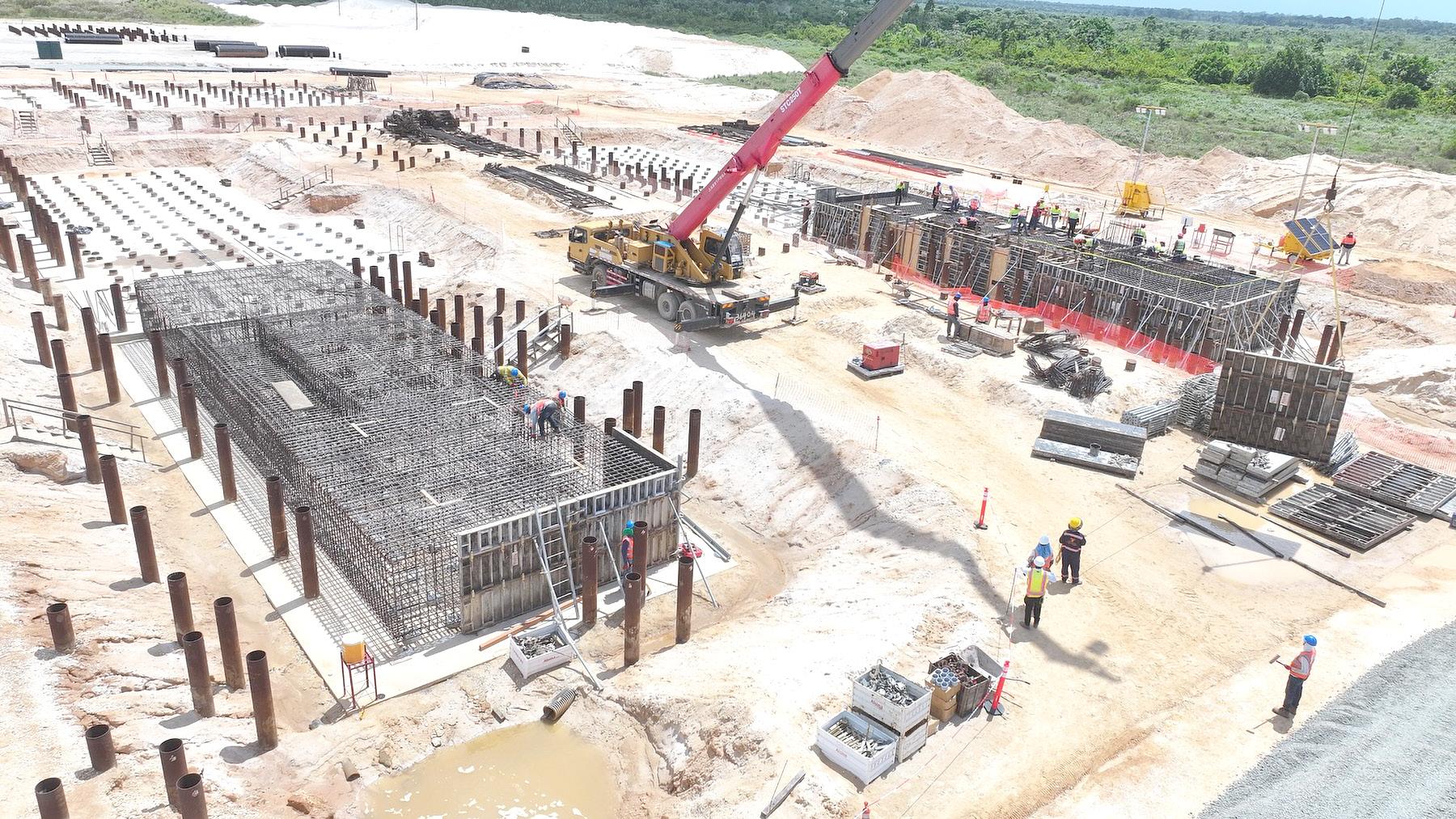
By Trina Williams
THE Gas-to-Energy (GtE) project, described by Bounty Farm Ltd. Managing Director, David Fernandes, as a “gamechanger”, along with the government’s planned suite of major infrastructural projects, including a deep-water port in Berbice, is expected to significantly reduce logistics costs, boost exports, and strengthen Guyana’s manufacturing base.
Fernandes made those remarks during a recent episode of the Starting Point podcast, where he discussed how Guyana’s economic landscape is being transformed and highlighted the emerging opportunities for local manufacturers and exporters.
The private sector leader underscored the significance of the GtE project, stressing that its benefits are not emphasised enough, noting that the transformative impact of it will not only slash electricity costs for the ordinary man but will revolutionise manufacturing and agriculture.
The business leader noted that there are benchmarks that affect every business, including interest rates, corporate tax, logistics costs, shipping, fuel costs, electricity costs, labour costs and input costs.
“That will obviously cut out our electricity costs by half, according to the government's suggestion, and I think you'll probably go further after that. So that's significant. Right away, we'll have significant relief in the personal houses in terms of people's costs, and in terms of
commercial operations.
“I think it'll be an unbelievable change, a game-changer for manufacturing in Guyana,” Fernandes said.
The GtE project represents Guyana’s determination to use its natural resources to lower costs, expand industries, and create new opportunities for citizens. With over two-thirds of the work already done and strong collaboration among the government, ExxonMobil Guyana, and contractors, the project is moving steadily towards completion.
The benefits of the GtE project extend beyond power, as Fernandes stated that it also has the opportunity to produce local fertiliser, which could reduce reliance on imports and save foreign
currency.
As Guyana positions itself as a regional leader, the influx of infrastructural upgrades, especially in transport and port facilities, is poised to address the logistical bottlenecks
The deep-water port, according to Fernandes, could give Guyana that edge to become competitive in several arenas. Last year, President Ali unveiled plans for the development of the Berbice deepwater facility. The head of state had noted that the port will be designed to improve trade, reduce shipping costs and integrate trade with northern Brazil.
John Fernandes and Muneshwers, two major Guyanese companies, joined forces to form the Cranes

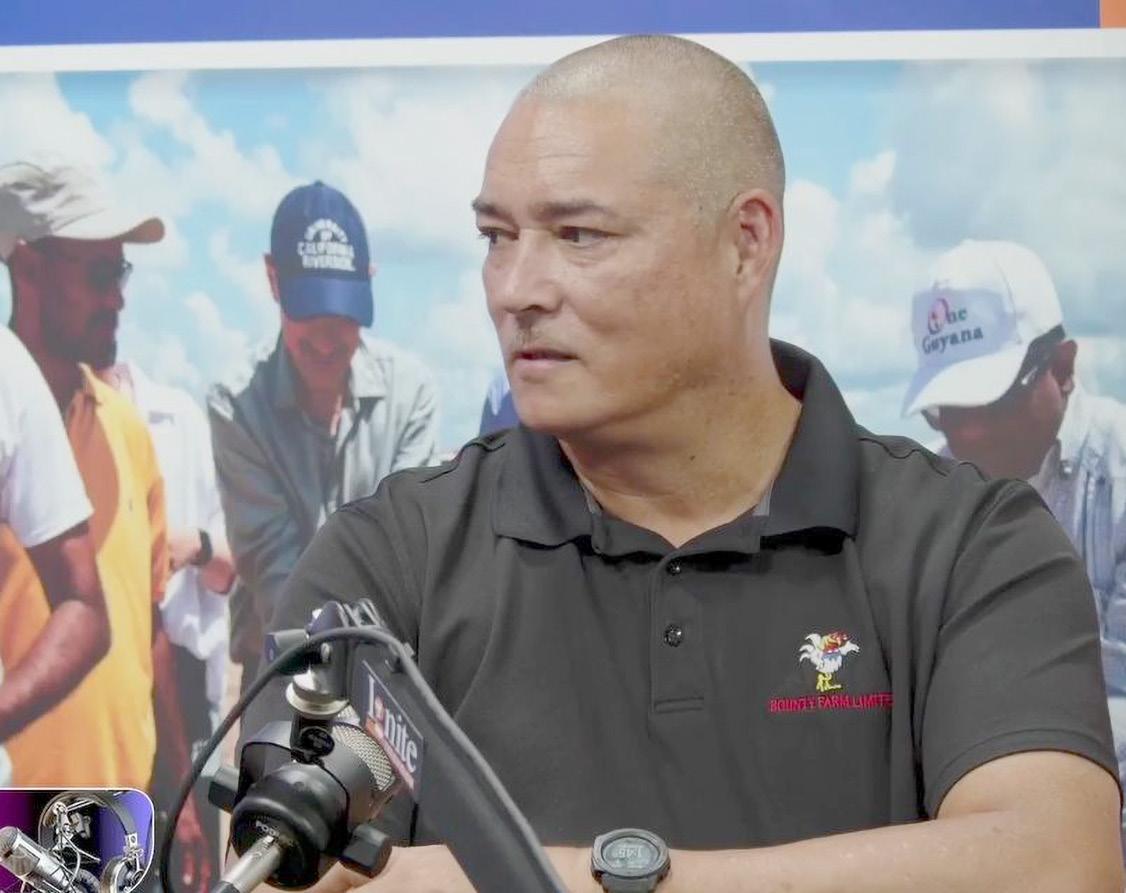
to turn the sod in the coming weeks.
Guyana Consortium, and on the heels of a recent venture that modernised the Georgetown port, they have made a major investment in Berbice.
Notably, some 1,000 jobs will be created as a result of a port facility in Berbice that will be built by John Fernandes and Muneshwers Ltd, two major port operation companies in Guyana that have joined forces to form the Cranes Guyana Consortium. This was announced by President, Dr. Irfaan Ali earlier this year.
The US$285 million facility is set to transform Berbice, and the President spoke about the opportunities it will unlock. The President said that the two major companies are raising the capital for the investment in the first phase of the facility and are hoping
In February, two mobile harbour cranes were commissioned as part of a new joint venture called ‘Cranes Guyana Inc,’ marking a bold and visionary step in the right direction and were hailed as a win for local content.
The cranes, which were named ‘Atlas’ and ‘Hercules’, were designed to serve Panamax class vessels with a working radius of 49 metres and a lifting capacity of 125 tonnes. At the time, President Ali commended the partnership between John
Fernandes and Muneshwers and congratulated them on prioritising national interest above self-interest.
According to officials from the companies, they approached the InterAmerican Development Bank and financing was sought for the procurement of the two cranes.
Operational trials commenced in November 2024, marking the inaugural servicing, loading, and discharging of gearless vessels at the Guyanese port, resulting in enhanced safety and efficiency.



DIWALI, the Festival of Lights, has always been a celebration of the triumph of light over darkness, good over evil, and knowledge over ignorance.
But this year’s observance at State House carried a deeper meaning for Guyana; it became a living expression of President Dr. Mohamed Irfaan Ali’s One Guyana vision, a philosophy that continues to shape the moral and social fabric of the nation.
On Friday evening, the lawns of State House glowed not only with the soft flicker of diyas and the joyous sounds of cultural performances, but also with the warmth of unity and shared identity.
President Ali, addressing a diverse gathering of citi-
zens, spiritual leaders, and officials, reminded the nation that “our diversity is not a challenge to overcome; it is a blessing to be celebrated”.
In a world where differences often divide, the President’s words resonated powerfully. His choice to host national religious and cultural events at the highest seat of the State is no token gesture; it is a deliberate act of inclusion. It signals that every Guyanese, regardless of faith, ethnicity, or background, belongs to this home.
Under President Ali’s leadership, the One Guyana initiative has evolved beyond rhetoric. It is now a living, breathing commitment reflected in policies that bridge divides, from equitable access to housing and educa-
tion, to the celebration of all major religious observances at the national level.
By opening the gates of State House to Diwali, Phagwah, Eid, and Christmas, the President has transformed what was once a symbol of authority into a house of the people, a space for harmony, cultural exchange, and national pride.
Friday night’s celebration carried a refreshing simplicity. There were no stiff formalities, no barriers of rank or status. Instead, there was laughter, music, shared meals, and a powerful sense of togetherness.
In the President’s own words, “Tonight is not meant to be a formal night; it is a night of spiritual upliftment and socialising with each other.” The symbolic act of
“breaking bread together”, or, as the President fondly put it, “dipping our fingers in the wonderful tradition of seven curry”, underscored the idea that unity begins at the communal table.
Equally noteworthy was President Ali’s acknowledgment of the corporate community, particularly Banks DIH and Citizens Bank, for their continued partnership.
His hint of “exciting news” for next year’s Diwali and Phagwah observances, tied to the company’s milestone anniversary, suggests a growing synergy between public and private efforts to promote Guyanese identity and national celebrations.
But beyond the festivities, the heart of the message lay in the reminder that Diwali’s light must extend
beyond a single evening.
The President called on citizens to be bearers of that light; to illuminate their communities with kindness, understanding, and a shared sense of purpose.
“When one lamp is lit, it can light a thousand more without losing its flame,” he said, offering a profound metaphor for unity and progress.
This year also marks the 50th Anniversary of the Guyana Hindu Dharmic Sabha, a remarkable milestone in the nation’s cultural and spiritual journey.
The President’s call for citizens to join Dr. Vindhya Persaud and the Sabha in Sunday’s grand Diwali motorcade further reinforces his belief that national celebrations belong to everyone, not
just to those of a particular faith.
As Guyana continues to grow and transform, the message of Diwali — and the One Guyana spirit it embodies — remains more vital than ever.
The nation’s strength lies not in uniformity, but in its dazzling mosaic of traditions, languages, and beliefs. When citizens gather under the same light, celebrating each other’s festivals and embracing each other’s stories, they do more than honour heritage — they build the foundation for a truly united Guyana.
This Diwali, under the soft glow of a thousand diyas, President Ali’s vision was not just spoken, it was lived. And in that light, the promise of One Guyana shines brighter than ever.
Dear Editor,
THE recent announcement by His Excellency President Irfaan Ali, commissioning a feasibility study for a Light Rail Transit (LRT) line along the East Bank Corridor, marks a special moment for our nation's infrastructure. This initiative is more than just a transportation project. It is a foundational investment in Guyana’s economic future and the well-being of its citizens.
The proposed LRT promises to serve as a powerful catalyst for progress in several critical areas:
2. Strategic Urban Development: Train stations in key locations, from Georgetown to the Cheddi Jagan International Airport (Eccles, Diamond, Garden of Eden, Land of Canaan, Soesdyke Junction), will become hubs for commercial and residential growth. This will guide our urban expansion in a structured and sustainable way.
3. Enhanced Global Competitiveness: A direct, efficient, and modern rail link between our capital and our primary international gateway is essential for attracting more tourism and more investment, projecting an image of a nation ready for the global stage.
1. Economic Decongestion: It offers a permanent, high-capacity solution to the notorious gridlock on the East Bank Demerara Public Road. This will free our workforce and commerce from the suffocating and slow road traffic on that corridor.

4. Public Safety: The most important of all the invaluable benefits is that of saving lives by reducing our nation’s tragic toll of road accidents. This reason cannot be overstated and must be central to the project’s justification.
From an engineering perspective, we must acknowledge the significant geotechnical challenges along parts of the corridor. The coastal plain’s susceptibility to liquefaction requires a thorough upfront investigation and robust mitigation strategies, including extensive pilings and specialized foundations. As we are already witnessing in the developments on the sugarcane lands at Wales and Ogle, this is complex and costly work. However, as the
adage wisely states, “nothing cheap is good.” The long-term benefits of a resilient and safe system that saves lives will far outweigh the initial capital investment.
Consequently, a traditional cost-benefit analysis is an inadequate tool for evaluating this project. A much more pragmatic approach by the researchers is needed. The pertinent questions to answer are: How does one quantify the value of a life saved, or the economic gain from thousands of hours of productive time no longer lost in traffic? This is the key!
The assessment must be reframed around its transformative potential: to enhance the quality of life for our people, boost national pro -
ductivity, and signal Guyana’s leap into a future population with modern and sustainable infrastructure.
The underlying economic imperative is clear. The journey from the airport forms the first and most lasting impression for visitors, investors, and Guyanese from the diaspora. The current experience of protracted delays creates a powerful negative perception that undermines our other achievements. A reliable transit link is a fundamental requirement for international business, which depends on predictability and efficiency. For our tourism sector, it is a competitive lifeline.
The Georgetown-to-CJIA corridor is an economic and strategic artery. For a nation experiencing rapid growth,
proactively building this high-capacity rail link is not an option, but a necessity. It is an investment that will yield dividends for decades by preventing the massive economic losses of perpetual gridlock and laying the foundation for a more connected, efficient, and equitable society.
In conclusion, President Ali’s directive to study the Light Rail Transit system is a forward-thinking and decisive act of leadership. It demonstrates a profound understanding of the intricate link between modern infrastructure, human development, and national prosperity. This is precisely the vision required to secure Guyana’s future.
Sincerely, Sasenarine Singh
By Feona Morrison
PRESIDENT Dr. Irfaan Ali has reaffirmed his government’s commitment to restoring Georgetown, pledging a comprehensive approach to cleaning up and modernising the capital city.
Speaking at the commissioning of the New Cummings Lodge Water Treatment Plant on Saturday, he said, “Your government is actively pursuing the full rescue of Georgetown. We have to clean it up, fix it up, nice it up, and place it among the most beautiful cities in this region.”
The President emphasised that the restoration process will be accelerated while involving residents in key de-
cisions. “From now, we’re going to start working in an accelerated way, but the people of Georgetown, you will have choices to make, and we want you to walk the long journey with us,” he stated. Dr. Ali detailed the practical steps planned for the city, starting with infrastructure improvements. “I’ve already directed that the full mapping and condition survey of every drain in the city be done based on GIS [Geographic Information System]. After that, we will launch a massive drainage programme across every street, every alley, every single area in Georgetown.”
He also announced plans to address urban housing challenges, noting, “I’ve asked
- announces decisive steps to tackle excessive gambling, other social challenges
for a full mapping of all the housing stock in Georgetown, so that we can develop a sustainable urban housing plan that will ensure housing stock issues in the city are dealt with.”
The President further highlighted the importance of recreation and quality of life. “I’ve also asked for a mapping of every recreational facility and a condition survey, so that we can invest in recreation to bring a quality of life in the city that leads to wellness.”
Last month, President Ali announced a plan to rescue Georgetown and restore the city to its historic reputation as the “Garden City”, while advancing sustainable urban development.
WHEN it comes to elections in Guyana over the past 20 years, the researcher has a goldmine at GECOM. What GECOM has done is to make available to the nation the results for each polling station.
There are entire districts where ethnic communities are concentrated. Three examples are powerfully conspicuous—South Georgetown, from the famous Le Repentir Cemetery going further south, consists of a concentration of African Guyanese.
Port Mourant is almost 98 percent Indian. And thirdly, it needs no mention where our Indigenous folks can be found. You take the statements of poll (SOPs) for these three areas of Guyana and you can tell which party lost and which party won and you make the logical deduction of ethnic cross-racial voting. That is scientific evidence that cannot be denied.
The scientific evidence points to Leonora giving overwhelming electoral support to the PPP. The President hails from that area. You cannot contradict that scientific evidence because it is there on paper, just as the SOP for Plaisance and Linden showed that Aubrey Norton lost votes in those two places, with the former being where he has lived a long time now and he comes from the latter. WIN got a huge amount of African votes and we know that because the SOPS for predominantly African places showed WIN left the PNC behind.
The 2025 general election was different from the earlier elections, omitting the rigged polls of 1968, 1973, and 1980 under President Burnham and1985 under President Hoye. In the elections of 1956, 1961, 1964, 1992, 1997, 2001, 2006, 2011, 2015, and 2020, the results closely approximated the ethnic composition in Guyana. One can say that from 1957, there was no substantial cross-racial voting that resulted in a huge gap between the two major parties. In 2006, the PNC was reduced to 36 percent but that reduction benefitted the AFC and not the PPP.

The only general election that saw phenomenal cross-racial voting was 2025. The WIN party was a huge recipient of cross-racial preferences but unlike the traditional voting patterns that the PPP has experienced and endured since 1957, the 2025 general election has broken the racial jinx for the PPP. The PPP received a large measure of African ballots that the nation has not seen in any election before.
My contention is that the politics, personality, and achievements of President Ali were the crucial factors in the PPP’s accomplishment of cross-racial embrace. I concede that oil money transformed the total horizon of Guyana, thereby allowing the incumbent to receive the gratitude of the nation. I concede that the PPP as an organisation campaigned astutely and was seen by people in a positive way. But in my analysis, the phenomenal dimension of the 2025 election results was the attitude of African Guyanese to President Ali
The present African generation is a very young one and they broke with their previous generation by moving away from the acceptance of ethnic pandering. African Guyanese showed no interest in the ethnic sermons of David Hinds, Rickford Burke, Tacuma Ogunseye, Mark Benschop, Aubrey Norton et al. They rejected these ethnic preachers for President Ali and the WIN party.
African Guyanese saw and see Irfaan Ali as a different politician from those that emerged since Independence. They believe he is not racially biased, believe he wants to accommodate African Guyanese in the futuris-
The plan outlines 15 landmark demonstration projects that will focus on ‘green’ infrastructure, climate resilience, and the celebration of cultural heritage.
Among the proposals are the transformation of the historic ‘transport building and train station’ into a museum and training centre, the creation of walking trails throughout the city, immediate upgrades to the Stabroek Waterfront, and improvements to key shopping areas.
The ‘Rescue Georgetown’ plan is part of the government’s broader strategy to modernise infrastructure, preserve the nation’s history, and create a vibrant, resilient capital city that inspires national pride, and attracts global recognition.
Beyond physical infrastructure, Dr. Ali underscored social and moral development as key pillars of Guyana’s development.
“I’ve asked the Cabinet to work on a programme to engage our churches, our mosques, and our temples on a plan to deal with social challenges in our society; on a plan to deal with civic and
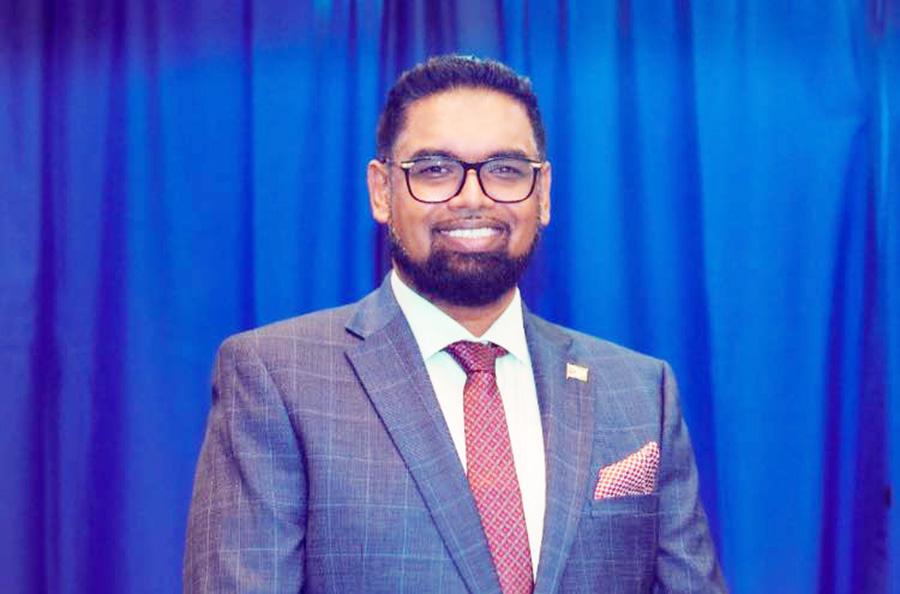
moral education, and on a plan to build quality citizens in Guyana, and we will be supporting the implementation of those plans,” he said.
He also addressed social safeguards, specifically gambling, urging citizens to be responsible with their resources. “Social safeguards and safeguarding your resources are important to your life’s development,” President Ali said.
He warned that the government would take decisive action on gambling, stating, “Those entities [gambling shops] have a responsibility to decide now. If you don’t help to fix it, we will have to fix you,” he said, emphasising measures to curb excessive gambling outside the legislation.
At a recent press conference, Vice-President Dr. Bharrat Jagdeo said that the government will soon introduce stronger regulations and higher taxes to address grow-
ing concerns related to gambling in Guyana.
He noted that while gambling was once confined to hotel-based casinos, it has now proliferated through mobile apps, causing social problems, particularly among single parents and mothers.
The Vice-President explained that gambling has become accessible on demand, reaching into homes through mobile apps, and noted that the situation has been exacerbated by a very liberal licensing and taxation policy.
“It’s destroying people. If they want to gamble, they can go to the appropriate place, leave their home and travel, not sit at home all day using up their salary or children’s money,” he urged.
Jagdeo noted that with hundreds of gambling outlets in villages across the country, all accessible through mobile apps, the situation is creating a major social problem.
tic pathways of Guyana and most of all, they believe they can talk to him and he will listen. That belief system about President Ali translated into votes for him in 2025.
As he enters the final five years of his role as a Guyanese patriot, there is a huge caveat that Dr. Ali has to be sensitive about and spend the next five years working on it. It was Vice-President Jagdeo who explained WIN’s success. He said there were African Guyanese that did not want to vote for the PPP and in rejecting the PNC, they chose WIN.
Here is a theory about WIN that President Ali needs to examine. I believe by 2030, WIN is going to be severely damaged. It is going to be a shell of itself. By that time, the PNC will be almost nonexistent. When that happens, Mr. Jagdeo’s words have to come into play- He said WIN’s voters did not want to vote for the PPP so they voted elsewhere
Those voters are African Guyanese and they are just over 100,000. Who are they going to vote for in 2030? My theory is the PPP (which will have Anil Nandlall as its presidential candidate) will attract them over from WIN if Dr. Ali spends the next five years attracting them. He will do it and he will succeed. Irfaan Ali may solve Guyana’s ethnic dilemma long before 2030. That will be the centre of his great legacy.
DISCLAIMER: The views and opinions expressed in this column are solely those of the author and do not necessarily reflect the official policy or position of the Guyana National Newspapers Limited.

NOBODY is buying the stories and tales that the People’s National Congress Reform (PNC/R), A Partnership for National Unity (APNU), and We Invest in Nationhood (WIN) are telling.
They are not truthful and honest about what took place before, during, and after the September 1, 2025 election; they want to kerfuffle the public with their dry and non-existent tears, but do not know that the plot of their alliance is yet to come full
circle. Guyanese should know that the ruling party, the People’s Progressive Party Civic (PPP/C), will have the last laugh when the arrangement between WIN and PNC/R-APNU really hits rock bottom. Only then will the PPP/C play its hand, exposing the mole in all of their backdoor deals.
For now, the PPP/C is happy to play politics, remaining watchful and careful with the desperate and imploding opposition. Be -
forehand, let’s discuss how some members of the public are being misled, lied to, and even taken advantage of by PNC and WIN principals and officials.
Firstly, WIN and PNC are not strangers to each other. In fact, they are bedfellows and Siamese twins. According to a source who chose to remain anonymous, top PNC-APNU officials have been in bed with WIN for years now.
There were several secret meetings and clandestine communication. The Alliance
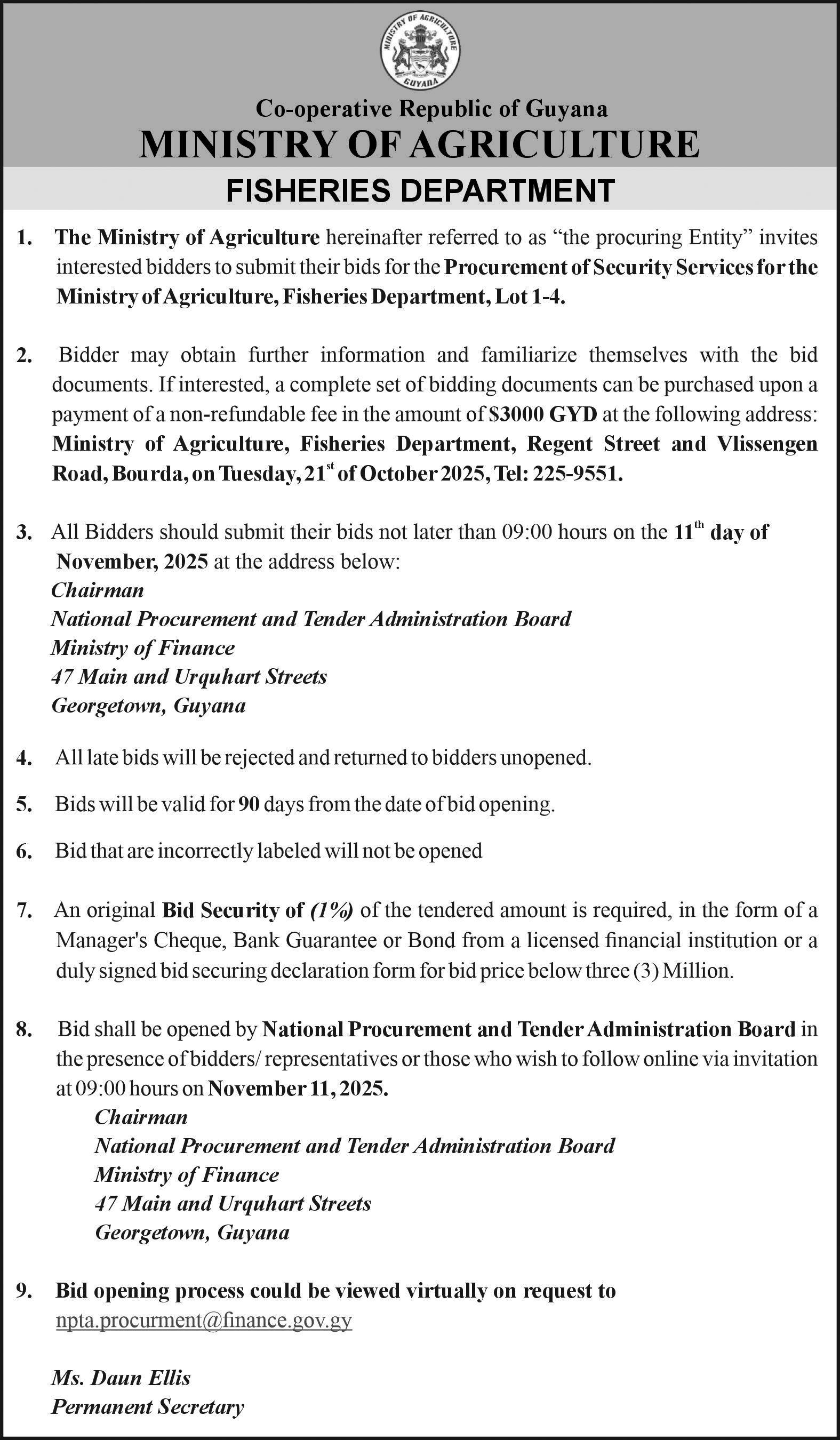

for Change (AFC) was also part of the talks. Its cover got blown after its general secretary and party leader were caught red-handed meeting the Mohameds in Hadfield Street.
Nevertheless, they plotted and schemed how to weaken the PPP/C long before the 2025 elections got underway. Then, in 2019, when the US announced sanctions were coming against individuals, including the Mohameds, it was clear that the plan would be put on the back burner, as PNC-APNU had much more to deal with, politically speaking. They subsequently called the elections and lost, but held on to power for five months.
When the dust settled, the Mohameds were sanctioned. Despite grovelling and begging at the PPP/C's feet, they did not get the type of response they were expecting. So, they re-ignited the flame with the opposition, the PNCR-APNU. They capitalised on Aubrey Norton’s weakness for money and power, while at the same time, the AFC’s greed and vindictiveness. Recall, they were caught meeting Raphel Trotman and Nigel Hughes.
The deal was that Norton would not criticise the Mohameds, and would lend them personnel and support, which would lead to legitimacy. And, Norton believed that he could finally get results and see the back of the PPP, even if it meant working handin- hand with the criminals. Also, there has already been a precedent set in the PNC, dating back to the ‘Blackie’ and ‘Fineman’ saga.
So, WIN and PNC are conjoined twins; they are connected at the hip.
Secondly, Norton’s PNC refrained from criticising the WIN during its bid for office, and to ‘change’ the dynamics of the country at the 2025 elections. WIN could never have prepared for the elections in the way they did without the help of PNC and PNCR-aligned resources. Personnel, party executives, party parliamentarians and
machinery were leased from Congress Place to WIN. The deflections and resignations, for the most part, were just a sham. It was just a part of the plot and strategy to fool and outsmart the PPP/C.
WIN launched and was accepted by mostly PNCR supporters. Noticing the trend, WIN fanned out in the hinterland and Amerindian communities where it preyed and desperately spread mistruths and lies about the PPP/C. It was attacking the PNC mote, but not as much as the PPP/C. And, by the time PNC/R recognised its folly and mistake, it was too late. WIN was replacing the PNC/R, and was not posing a big threat to the PPP/C.
The PNC/R spent all the money it had received, and its coffers ran dry. WIN had taken advantage of its weaknesses and played it into third place. Thirdly, WIN took the opposition leader post, and became the main opposition parliamentary party, leaving the once mighty party nibbling at the crumbs.
Let’s be clear, the PPP knew all along what was happening, and this was even forewarned by the General Secretary, Bharrat Jagdeo. In fact, he warned the PNC/RAPNU about the Mohameds no less than eight times, from June until August.
The PNC/R still tried to ally with WIN, as evidenced by the social media posts of Terrence Campbell, Sharma Solomon, and APNU. Talks and agreements broke down.
The elections of RDC Chairmen and Vice- Chairmen were haunted by suspicions, distrust, and bad blood, and so, it was PPP/C which ended up benefitting the most.
The PPP/C never entered into formal or informal talks with either the WIN or APNU. The Forward Guyana Movement (FGM) was left locked out of the decision-making spots by a greedy WIN and APNU.
And, the bombshell revelation of former parliamentarian Darren Wade made matters clearer and worse for the APNU and WIN. He ex-

posed that they were working all along. He did not feel any guilt or shame that he was a beneficiary of money from WIN. After all, he worked for it, on the instructions of his party leaders. This position vindicates the PPP/C, and proves the new alliance of WIN-APNU.
If any party is to be blamed, it would be APNU. PNC/R-APNU benefitted from the largesse of the Mohameds’ dirty money. It neglected so many red flags which were evident to all, and it did not take the advice of the PPP/C when the party was warning it about the desperation of the Mohameds. The APNU played with WIN, and WIN shafted it. It doubled-crossed them and poured cold water on their unwritten agreement. APNU allowed itself to be compromised, politically and financially. Recall, the power of money and wealth in the elections had a debilitating effect on the outcome. It swallowed whatever integrity and discipline the party had left.
WIN is not an angel either. Azruddin and Nazar Mohamed know what they did to benefit from those parliamentary seats. They cannot be trusted, and they set the bar so low for opposition politics in this country that it will take APNU two years to gain the support of its members back. WIN appears to be riding on APNU’s coattails. It is even seen as apologising for the PNC-APNU’s breach of Forbes Burnham’s legacy, and using that same legacy against the party.
WIN has been crying ever since the US made good on its promise of sanctions by following up with 11 serious indictments, which carry a 20-year imprisonment for each indictment. With the parliament set to commence soon, Mohamed is ditching the law and trying to use every resource to remain in Guyana. WIN leadership is also compromised and spineless. It betrayed the PNC and opposition politics. It did not play by the rules.
WIN cannot be trusted.
DISCLAIMER: The views and opinions expressed in this column are solely those of the author and do not necessarily reflect the official policy or position of the Guyana National Newspapers Limited.
ON September 29, just about a month after he was re-elected, President Irfaan Ali called for a “mature and open” discussion on the expanding US naval and anti-narcotics operations in the Caribbean, urging CARICOM heads of state to approach the matter “with eyes wide open.”
In an interview with journalist Kiana Wilburg, President Ali stated that while Guyana supports efforts against drug trafficking, it is important to ensure that the Caribbean remains a “zone of peace.”
The president is right, of course, and so is Vice President Bharrat Jagdeo, who called on the Guyana Police Force (GPF) a few days ago to ferret out any Guyanese who might be aiding and abetting criminals.
Drug trafficking is a global epidemic, one that claims the innocent lives of thousands every day.
The 1988 United Nations Convention against Illicit Traffic in Narcotic Drugs and Psychotropic Substances legally binds Guyana to not only criminalise drug production, trafficking, and money laundering, but it also compels Georgetown to co-operate in extradition, providing mutual legal assistance and maritime interdiction.
Guyana is also part of the Inter-American Drug Abuse Control Commission under the Organisation of American States (OAS). Under the CARICOM’s Implementing Agency for Crime and Security and the CARICOM Crime and Security Strategy of 2013, Guyana prioritises intelligence sharing and joint maritime operations against narco-traffickers.
That’s not all. Guyana has a Maritime Counter-Narcotics Cooperation Agreement with the United States. Under this treaty, Guyanese law enforcement officials can serve as “shipriders” on U.S. vessels, authorising operations in Guyana’s territorial waters in joint pursuit of suspect narco-vessels. This particular agreement allows for coordinated patrols, enforcement actions, and mutual support to prevent drug trafficking by sea and air.
Under the Caribbean Basin Security Initiative
(CBSI), Guyana benefits from U.S.-funded training, technical assistance, and security infrastructure upgrades. In March 2024, the United States provided US$300,000 in new bilateral funding under CBSI, along with a US$350,000 investment through the “Better Police Readiness Program” to modernise the GPF and enhance anti-drug capabilities. This followed a series of training and equipment-based initiatives by the U.S. Bureau of International Narcotics and Law Enforcement Affairs (INL), including DEA and FBI technical programmes and ballistic forensics support.
When President Ali called for a “mature and open” discussion, even debate, it must take stock of Guyana’s legal obligations before it segues to the five, possibly six, alleged narco-boats off the coast of Venezuela that the US military has destroyed since early September. President Donald Trump and his administration are serious about their “war on narco-terrorism.” Only a fool would think he or his administration is blustering at this point.
But what impact will the killing of over 27 alleged narco-terrorists in just over a month have on drug trafficking? No one really knows for sure. The 11 people on board the first speedboat with four outboard motors that was blown to smithereens on Sept. 1-2 were most certainly carrying a large payload of drugs. According to law enforcement experts, these types of boats are referred to as “go-fasts” and are outfitted to cover long distances with a small crew quickly.
The individuals on board these ‘go-fasts’ boats are mostly from the coastal town of San Juan de Unare, in the Venezuelan state of Sucre, which sits about 180 kilometres from Trinidad and Tobago. US and regional authorities have said that San Juan de Unare is a transhipment point for drug smugglers. On his Truth Social platform, President Trump described the crew as members of Tren de Aragua (TDA), designated by the US as a Foreign Terrorist Organisation that operates under the control of Nicholas Maduro.
As for Maduro, President Trump described him as “one of the largest narcotics traffickers in the world.”
This characterisation is based largely on a 2020 US indictment, which described Maduro and his second in command, Diosdado Cabello, as the “leaders and managers of the Cártel de Los Soles, or ‘Cartel of the Suns.”
As I write this column, I am looking out over the
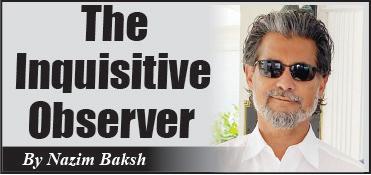
Atlantic on a windy Saturday afternoon.
On the surface, it appears relatively calm, but looks can be deceiving.
Transnational criminal networks can adapt faster than any armed drone could chase and destroy them.
The destruction of six alleged narco-boats is certainly a show of force, but if recent history has taught us any
lesson, the cocaine pipelines from the south to the north or from west to east across the Atlantic can adapt and divert their supply chains to off-radar routes.
President Ali’s call for a “mature and open” discussion is not a plea for neutrality but a recognition that the region’s peace depends on foresight: confronting the trafficking networks without surrender-
ing sovereignty, and working with allies without getting subsumed in the turquoise waters of the Caribbean.
DISCLAIMER: The views and opinions expressed in this column are solely those of the author and do not necessarily reflect the official policy or position of the Guyana National Newspapers Limited.
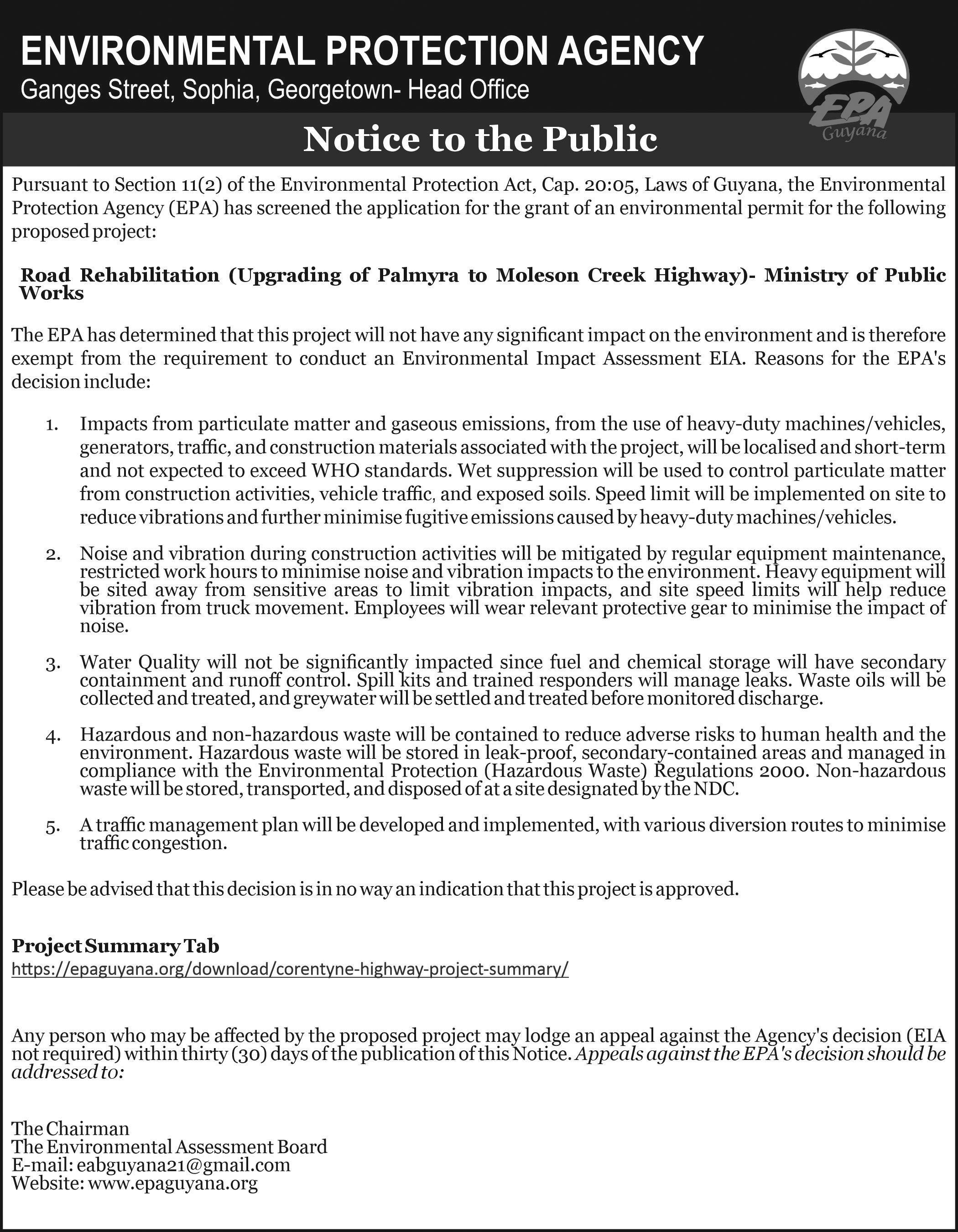

GUYANA’S oil and gas industry is expanding at an unprecedented pace. Yet, amid this acceleration, one question has become increasingly urgent: are our local workers ready to meet the rising demand for skilled professionals?
The competition for tal-
ent has intensified, not only in oil and gas but also in construction, infrastructure, and transportation. Without a skilled workforce, sustaining Guyana’s ambitious growth plans will be a serious challenge, especially as operations expand and technical demands increase.

In 2023, the Centre for Local Business Development (CLBD) conducted a labour survey that highlighted the scale of this challenge. The study revealed that over 53,000 new workers will be needed across key sectors over the next five years. Supporting this, Minister of Labour and Manpower Planning, Keoma Griffith, noted that Guyana’s rapid economic growth, projected at 10.3% in 2025, must be matched by investments in people to ensure that prosperity benefits the workforce.
This is precisely where initiatives like the Guyana Technical Training College Inc. (GTTCI), through the support of ExxonMobil Guyana Limited, SBM Offshore

Guyana and the Government of Guyana, make a real difference.
The College recently welcomed its first full cohort in the Advanced Diploma in Oil and Gas programme at its Port Mourant campus in Berbice.
This 18-month course provides hands-on training in Mechanical, Electrical, Instrumentation, and Production disciplines, all essential for offshore operations.
In the past, trainees completed parts of their studies in Canada. Today, for the first time, every aspect of the programme is delivered right here in Guyana. With modern classrooms, specialised workshops, and a high-tech Facility Simulator
(FacTor), students can now complete their training entirely at home. This approach reduces costs, retains talent, and strengthens the country’s local content and workforce capability.
The inaugural cohort includes 28 trainees from leading industry companies: 20 from SBM Offshore Guyana, six from MODEC, and two from Puffer Guyana. They represent the first wave of professionals fully trained in-country. The programme is internationally accredited by the UK’s City & Guilds, ensuring that graduates meet global standards and remain competitive both locally and internationally.
More importantly, this initiative is about empow -
ering people. By providing fully local, internationally-recognised training, GTTCI ensures that the wealth generated from Guyana’s oil and gas sector translates into local opportunity.
As Guyana continues to harness its oil and gas resources, one truth stands out: the greatest resource shaping the nation’s future is not just what lies beneath the seabed, it is the people above it, now fully trained and ready to lead.
DISCLAIMER: The views and opinions expressed in this column are solely those of the author and do not necessarily reflect the official policy or position of the Guyana National Newspapers Limited.

THE cry was, “My mental health matters!” chanted by an eclectic group of Guyanese, mostly young people, as they marched, waving glow sticks and strips on Saturday before last.
Wearing green-and-white T-shirts proclaiming mental health awareness, the group assembled at the Bank of Guyana building at the head of Main Street.
They chatted, laughed, and danced to music by DJ Avalanche, all while preparing to show solidarity with those struggling with mental health challenges.
But beyond the lively atmosphere, the march (from the Bank, down Main Street, up Waterloo, and back to the starting point) sought to highlight that here in Guyana, as in the rest of the world, many people battle daily with mental health issues.
By taking the issue to the streets, the Mental Health March also aimed to reduce the ever-present stigma, and lift the shroud of secrecy surrounding those often dismissed as “mad”.
It was another step in an international movement to bring mental health out of the shadows, and acknowledge, as the World Health Organisation (WHO) contends, that “there is no health without mental health”.
When actors, athletes, and other prominent figures began publicly discussing their struggles with anxiety and depression, the world started to take notice. One of the first was the swimmer Michael Phelps, who, in his early career, believed admitting to mental health issues, particularly anxiety and depression, both of which he experienced, would expose vulnerability and give his competitors an advantage. To cope, he learnt to compartmentalise his emotions, but this only caused them to reach uncontrollable levels.
Phelps later confessed to experiencing “post-Olympic depression” following both the 2004 and 2008 Olympics, and finally acknowledged in 2014 that he had a problem that needed attention.
One of the most important
lessons he has since learnt, after undergoing therapy, is that admitting vulnerability is a strength; not a weakness. He now discusses his emotions openly with friends and family, and even produced a documentary, The Weight of Gold, to help end the stigma surrounding mental health, particularly for male athletes.
In encouraging others to seek help, Phelps began saying, “It’s okay not to be okay”, a phrase that quickly became a rallying cry for mental health awareness. He openly accepts that his depression and anxiety will not simply disappear, and has developed a strategy that includes physical training and ongoing mental health counselling.
To the outside world, it may have seemed that Phelps, an Olympic legend with 23 gold medals, had nothing to worry about. Yet, despite his extraordinary success, he admitted that after each fouryear Olympic cycle, he began “struggling with life”.
He told NBC in an interview, “It’s basically like you

get to the edge of a cliff, like, ‘Cool, now what? Oh, I guess I’ve got to wait four more years to have the chance to do it again.’”
When the same feeling returned after the 2008 Olympics, “coming off that high after doing something you’ve set out to do your whole entire life”, Phelps finally recognised the depth of his struggle.
To be continued next week.

DISCLAIMER: The views and opinions expressed in this column are solely those of the author and do not necessarily reflect the official policy or position of the Guyana National Newspapers Limited.
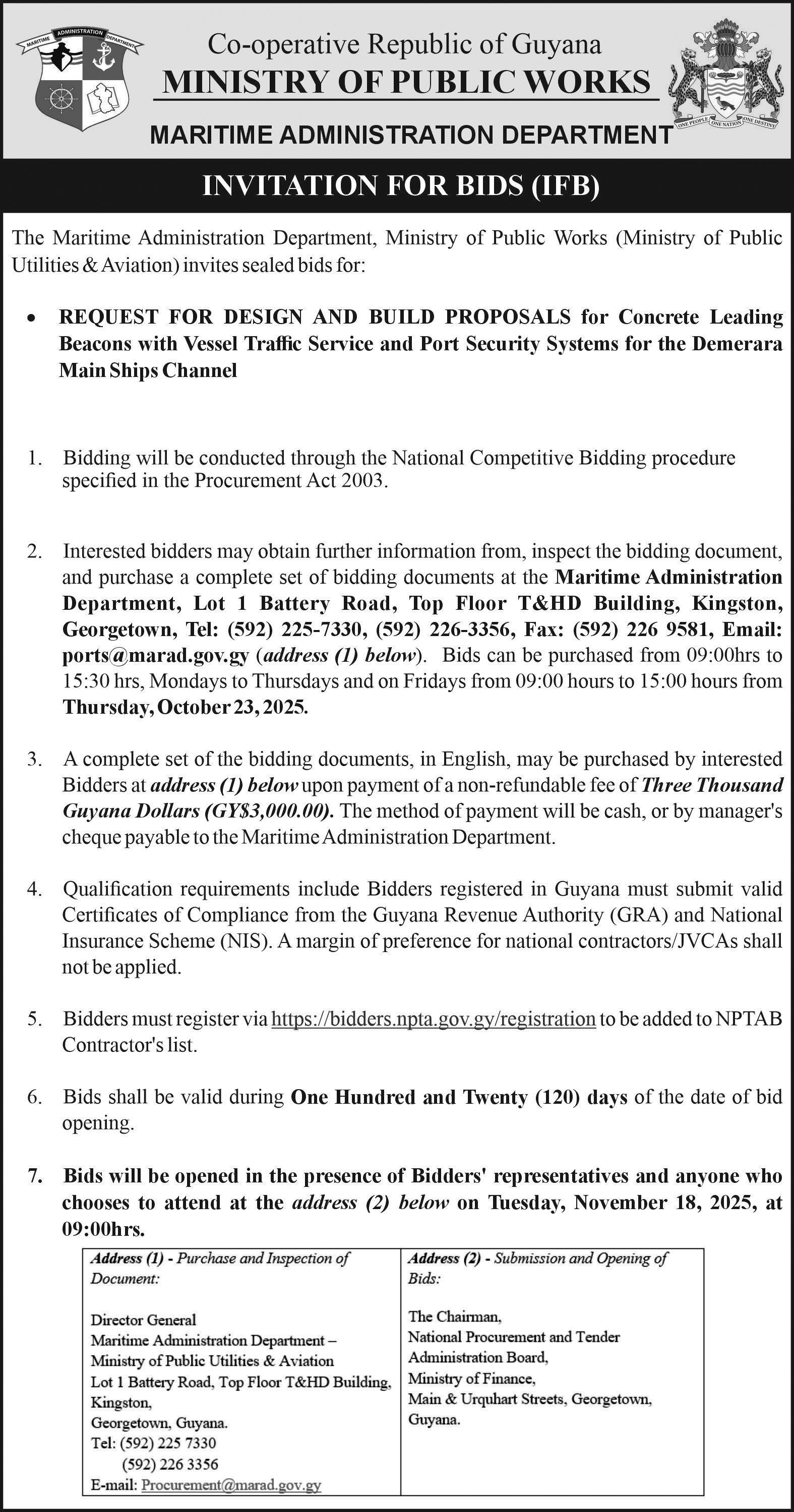
AS Guyana continues its economic and infrastructural development, Commander-in-Chief of the Armed Forces, President Dr. Irfaan
Ali, has urged the Guyana Defence Force (GDF) to evolve in step and match the nation’s transformation. He made these remarks
on Friday last as he administered the instruments of commission and state warrants while commending those officers for their dedication

and achievement.
President Ali said: “As Guyana continues its journey of transformation, driven by new industries, new infrastructure and new opportunities. The Defence Force must mirror that transformation. You must be the embodiment of the discipline, co-operation and foresight that our nation itself strives to achieve.”
As he continued to address those officers, the President reminded them that the instrument bestowed is not one of privilege but of responsibility to Guyana and its Constitution.
“You are assuming leadership at a time of rapid transformation, both within our country and across the global security environment. The nature of warfare and defence has evolved.
“Traditional threats are now compounded by transnational risk, cyber intrusion, narco trafficking, illegal fishing, environmental disasters and the ripple effect of regional instability. Modern military leadership requires more than physical readiness. It demands strategic thinking, technological confidence and adaptability,” the Head of State said.
Dr Ali said that the officer must be as comfortable with data and digital tools as with
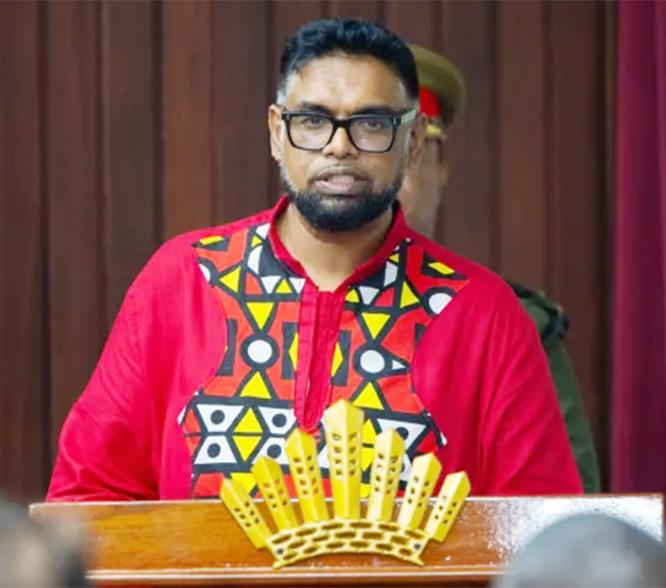
discipline and drills, noting that the GDF is committed to continuous education, to ensure officers develop the skills necessary for a modern, agile and technologically advanced military.
The president further noted that the GDF is a partner in nation building, whether responding to plots, supporting law enforcement or assisting community development, “the GDF must always act as a unifying symbol of national pride and stability,” President Ali told the officers.
Si nce 2019, the GDF’s budget has increased tremendously, from $13.9 billion to $50.4 billion this year.
Key investments include new aircraft, helicopters, patrol boats, and hangars, with a capital budget rising from $1.03 billion to $24.5 billion.
Last year, President Ali said that as part of efforts to fully optimise the capabilities
of Guyanese servicemen and women, there are plans to further expose the Guyana Defence Force (GDF) to greater training and technology.
Dr. Ali said: “We are building a new Defence Force, a Defence Force that is focused heavily on the future [and] the use of new technology.”
The president related that with these newer technologies, new forms of training will be needed. To this end, the government will ensure that ranks are equipped with the necessary training.
The Head of State had keenly pointed out the government’s commitment to national security and development through significant investments in military training and infrastructure.
These investments, he reiterated, reflect the government’s commitment to building resilient and robust military infrastructure.
THE Ministry of Education (MoE) has denied claims that a teacher from the Beterverwagting (BV) Primary School was transferred after speaking out about a pigeon infestation at the institution.
In a public statement on Saturday, the ministry said no teacher from BV Primary had been transferred in connection with raising concerns about the school’s condition, nor was any such transfer being considered by the Ministry or the Teaching Service Commission (TSC).
“At no time has any directive been issued by the Ministry to relocate or penalise a teacher for voicing workplace concerns regarding conditions at their school,” the statement read.
Chief Education Officer Saddam Hussain noted that the ministry recognises and respects the rights of teachers to raise concerns about school infrastructure and remains committed to addressing any genuine issues of maintenance.
He added that all staffing changes continue to be guided
by established protocols and conducted in accordance with national policies, collective agreements, and labour laws.
The ministry also urged
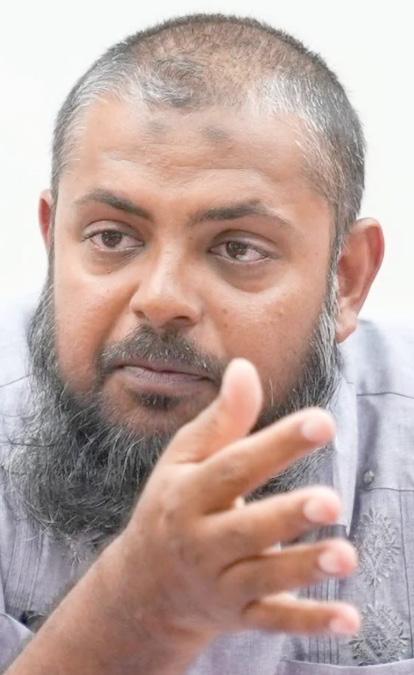
stakeholders to ensure the responsible dissemination of information, stressing the importance of accuracy, confiden-
tiality, and ethical use.
The clarification comes after President of the Guyana Teachers’ Union (GTU), Coretta McDonald, condemned what she described as the “transfer” of a BV Primary teacher who reportedly spoke publicly about the pigeon infestation.
In an interview with Stabroek News, McDonald said the GTU viewed the alleged transfer as “a blatant act of intimidation and victimisation.” She further argued that such actions would be contrary to the rights of workers as set out in the Constitution and labour laws.
McDonald also criticised the ministry and regional authorities, claiming that the issue at BV Primary was longstanding and had worsened due to what she described as administrative inaction.
The ministry’s statement, however, firmly rejected any suggestion of punitive action against the teacher, reiterating its commitment to fairness and proper procedure in all personnel matters.
-- David Fernandes says Guyana is ‘lucky’ to be the only country that is self-sufficient in food production -- Highlights govt’s efforts
By Trina Williams
GUYANA’s ambitious goal of agricultural self-sufficiency and value-added production is gaining traction as over US$10 million has been invested in the flagship corn and soya beans project, which is transforming the country into a regional powerhouse.
This was disclosed by the Lead Director and Chairman of the project, David Fernandes, during his appearance on the Starting Point Podcast last week.
The corn and soya beans production is being undertaken by a group of mainly local investors under the name “Tacama Gold”. The investors are the owners of Guyana
Stock Feed Limited, Royal Chicken, Edun Farms, SBM Wood, Dubulay Ranch and Bounty Farm Limited, along with the Brazilian-owned N F Agriculture. Fernandes is also the Managing Director of Bounty Farm Ltd.
During the discussion, Fernandes highlighted that this project, among other initiatives - which are being pushed by the government - signals a strategic shift towards economic diversification and sustainable development, even as the burgeoning oil and gas sector dominates headlines.
Guyana’s future extends well beyond oil and gas, as in August, it was reported locally harvested soybeans were transported by vessel, for the
first time, from the Tacama drying and storage facility, located approximately 90 miles up the Berbice River, to a processing mill where it was then converted into poultry feed.
President Irfaan Ali announced the development and highlighted the achievement as a landmark moment, given the fact that the project commenced in 2021.
Guyana is expected to achieve self-sufficiency in the production of all livestock feed, resulting in a decreased reliance on imports.
This progress is evident as 12,000 acres of corn and soya were produced in 2024. To become self-sufficient, the government invested significantly in the Tacama, Savan-

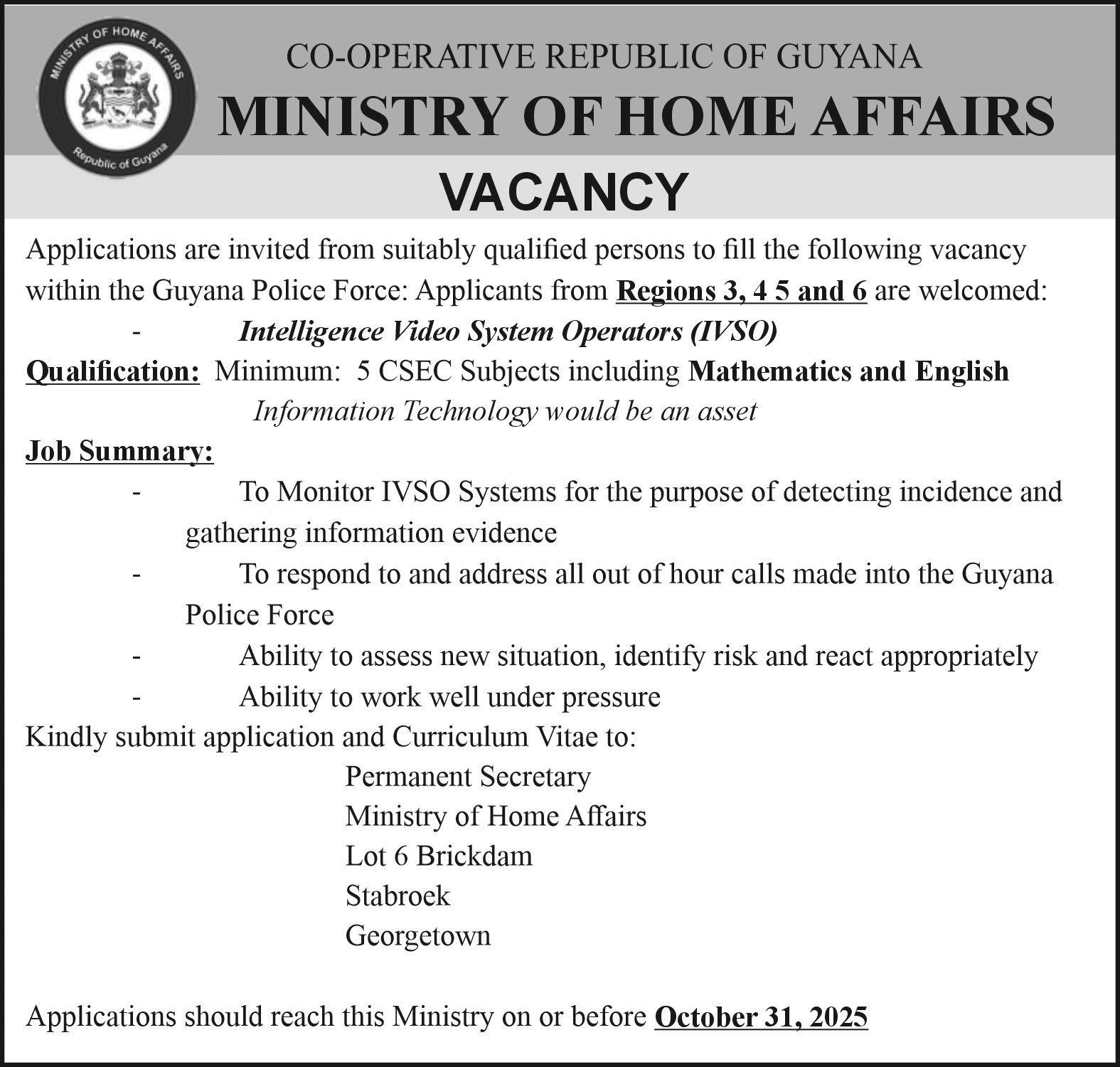
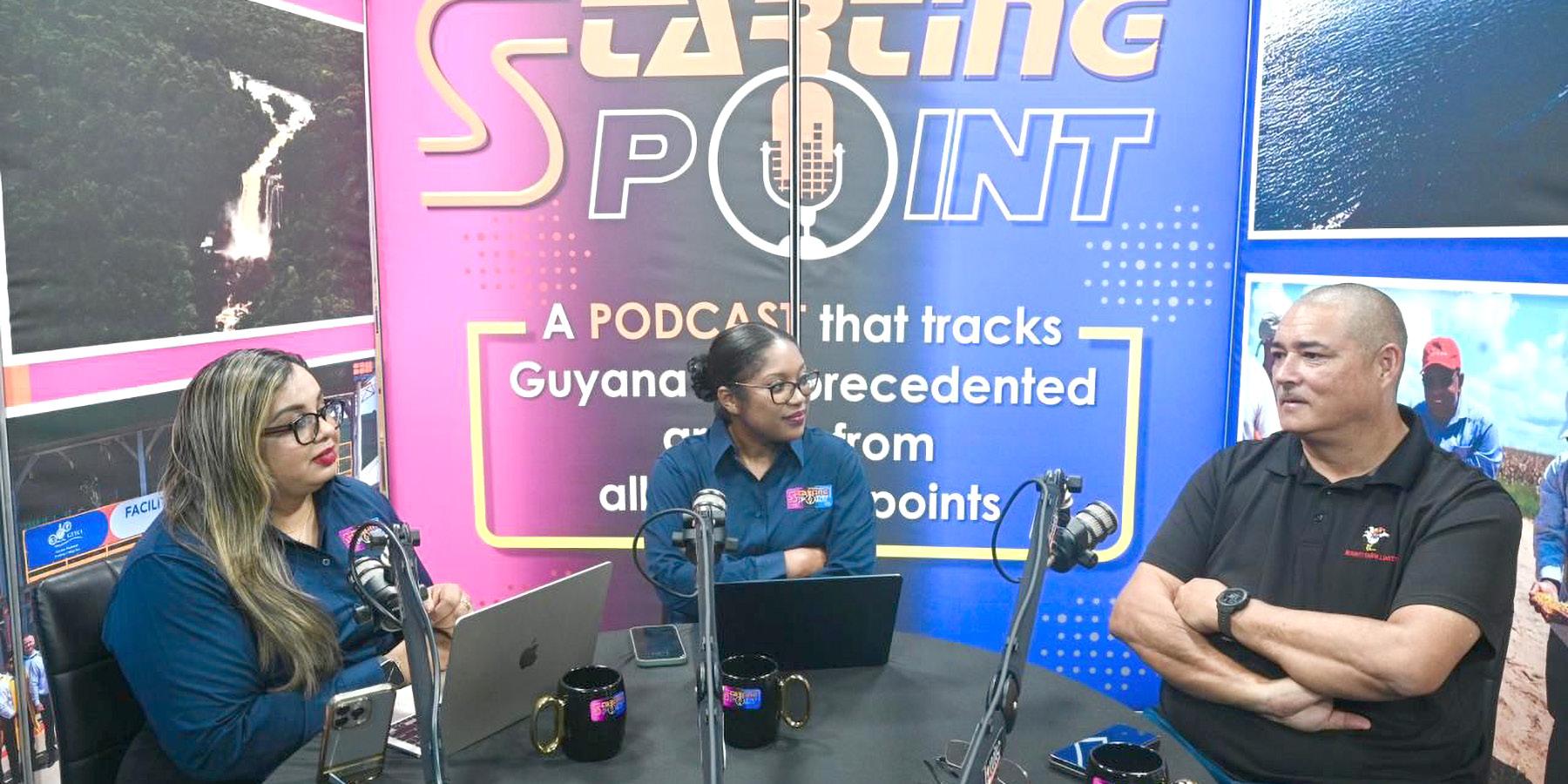
nah area [along the Berbice River], where more than 40 kilometres of road have been constructed.
While initially there was not much optimism about
being able to tackle the grain industry, Fernandes said,
“As Richard Branson always says, ‘If someone gives you an opportunity, say yes, and then try to figure it out, be-
cause the opportunity doesn't come again,’ because if you say no, he'll give someone else the opportunity.”
While those companies TURN TO PAGE 19
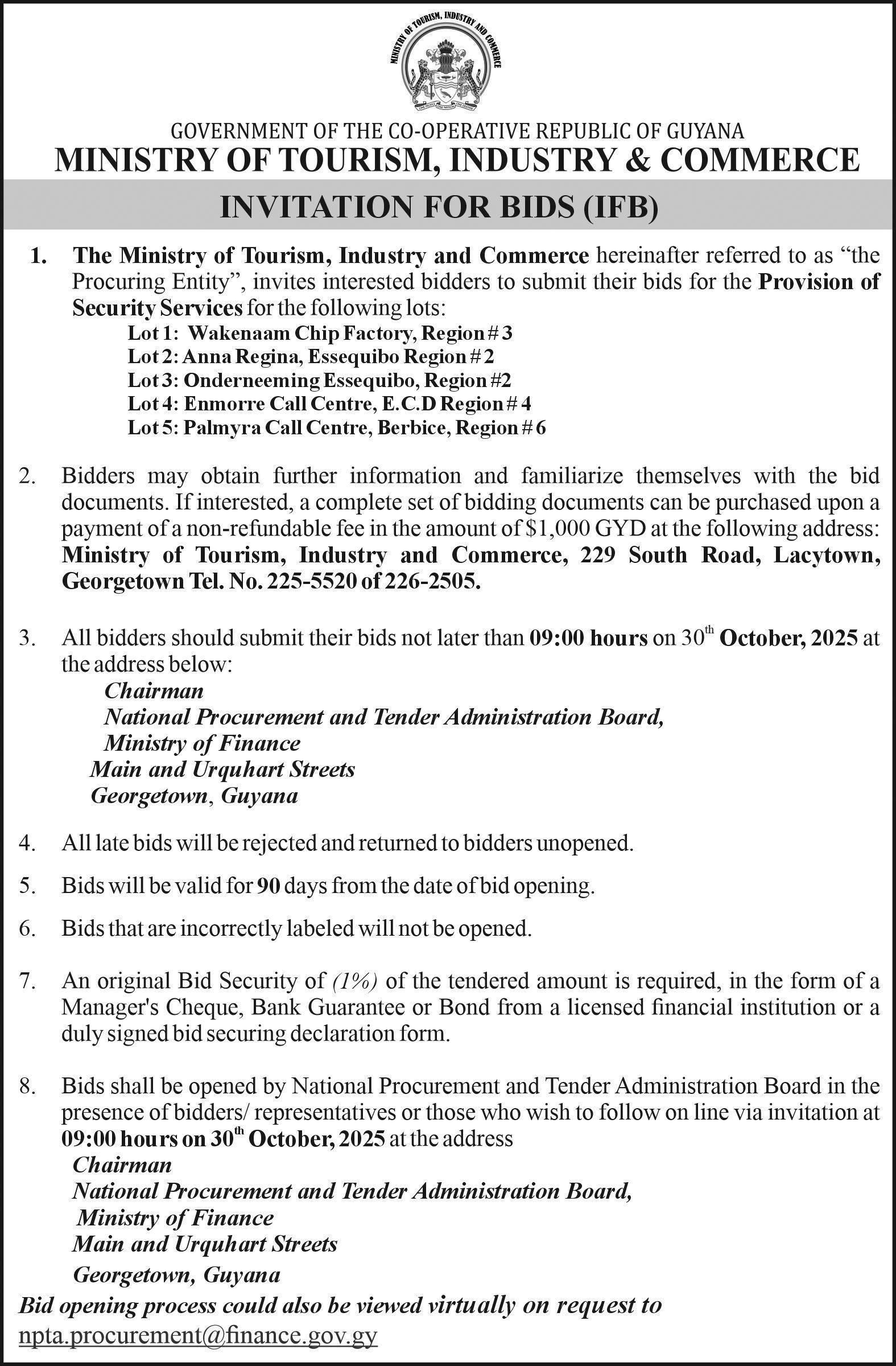
HEADS of Government of the Caribbean Community (CARICOM) have reaffirmed their commitment to maintaining the Caribbean as a Zone of Peace, amid growing concern over increased security build-up in the region by the United States of America.
A statement from CARICOM, on Saturday, noted that the regional leaders met recently to discuss a range of issues on CARICOM’s agenda, including the implications of the heightened military presence and activities in the Caribbean. Trinidad and Tobago reserved its position on the matter, while other Member States agreed on a common stance.
In their joint position, the Heads of Government underscored the importance of dialogue and engagement in achieving the peaceful resolution of disputes and conflicts. CARICOM also reiterated its willingness to assist in promoting peace and stability in the region.
The leaders further renewed their commitment to combatting narcotrafficking and the illicit trade in small arms and light weapons, both of which they said continue to threaten regional security. They emphasised that such efforts must be pursued through international co-operation and in full accordance with international law.
Additionally, CARICOM Heads reaffirmed their unequivocal support for the sovereignty and territorial integrity of all countries within the region, as well as the safety and livelihoods of Caribbean citizens.
U.S. President Donald Trump has said combatting drug cartels is a central goal for his administration and U.S. officials have told Reuters that the military efforts aim to address threats from those cartels.
Stephen Miller, deputy White House chief of staff, noted, in September, that the military buildup was aimed to "combat and dismantle
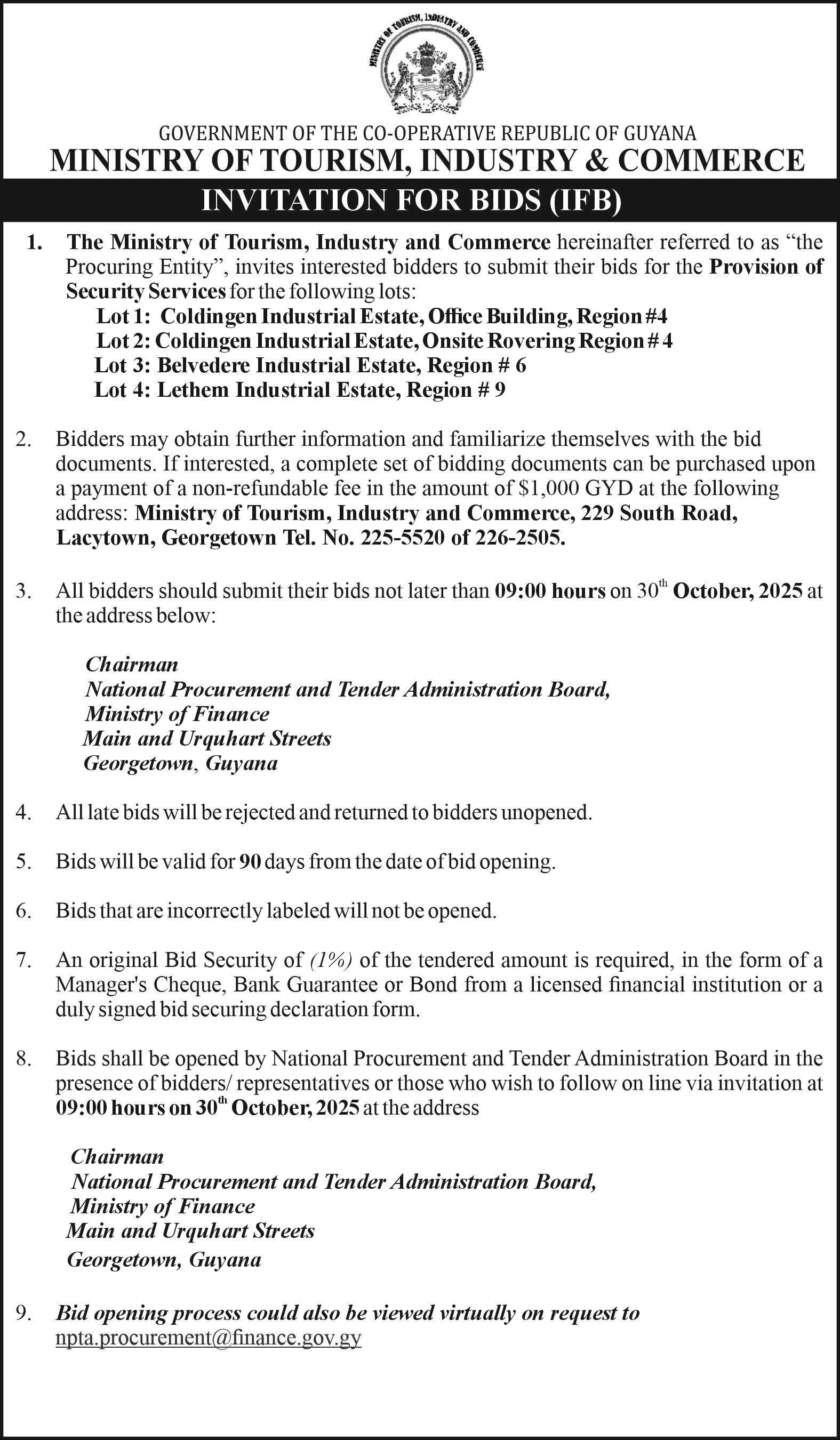
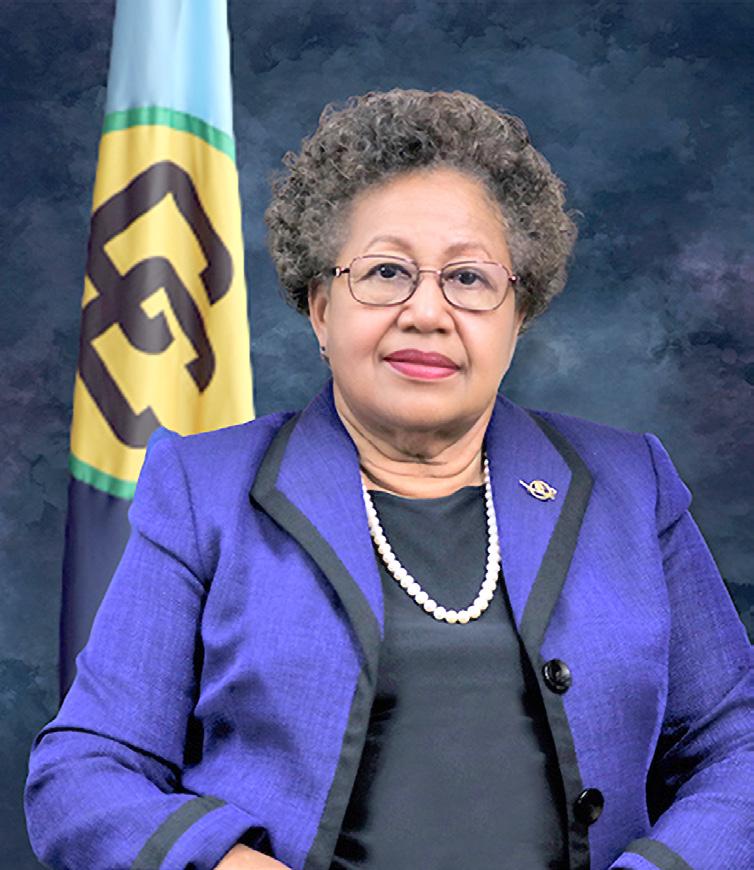
drug trafficking organisations, criminal cartels and these foreign terrorist organisations in our hemisphere."
According to Reuters, the United States has acknowledged carrying out at least five strikes on vessels near Venezuela that it says were transporting drugs, killing at least 27 people.
Reuters further reported that a sixth strike targeted a suspected drug vessel in the Caribbean on Thursday last, and in what is believed to be the first such case, there were survivors among the crew, who were rescued and are being held on a Navy ship.
The U.S. has described some of the victims in the first five strikes as Venezuelans, while Colombian President Gustavo Petro has suggested some were from his country. In Trinidad, family members of one man believed killed in a strike last week have demanded proof he was a drug trafficker, Reuters reported.

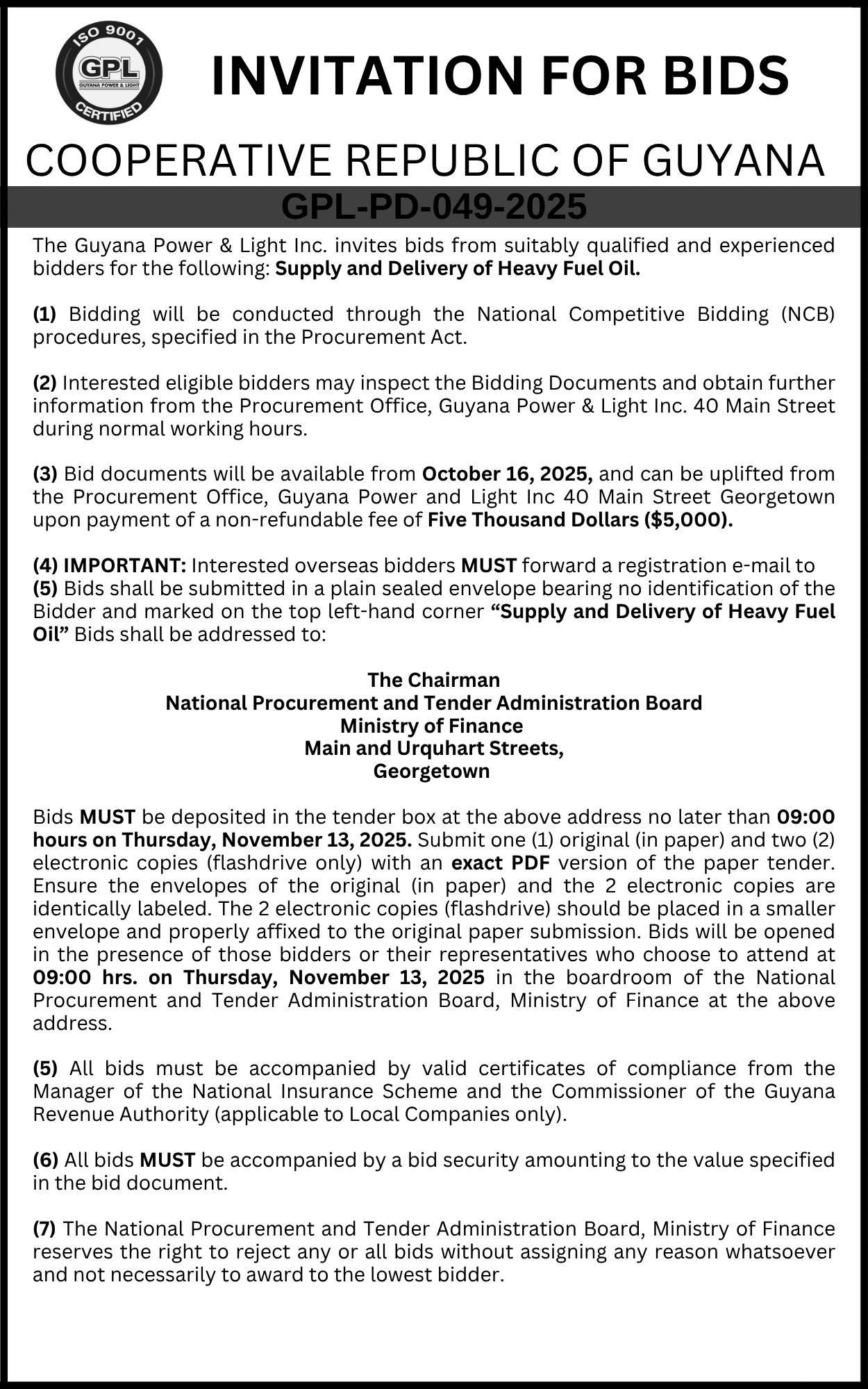





By Rabindra Rooplall
THE solemn halls of the Victoria Law Courts in Georgetown were filled with emotion and pride, on Thursday, as Fenton Jonathan Budhram was officially admitted to the Bar of the Supreme Court of Judicature, marking the beginning of his career as an Attorney-at-Law.

The petition for Budhram’s admission was presented by Director of Public Prosecutions (DPP), Senior Counsel Shalimar Ali-Hack, before Acting Chief Justice Navindra Singh, who formally accepted the application and welcomed him to the legal fraternity.
In his address to the court, Budhram’s words reflected deep humility and gratitude,
confidence, curiosity and conviction.”

not only for the honour of being admitted but also for the collective strength of family, mentorship, and perseverance that shaped his journey.
Quoting the late American novelist Sidney Sheldon — “Life is like a novel, it’s filled with suspense, you have no idea what is going to happen until you turn the page” — Budhram told the court that every person he encountered along his journey had helped him turn the pages of his own story “with
That story, he said, was written around what he fondly described as “the table of determination.” Recalling a defining memory of his teenage years, he painted a picture of his entire family studying together at the dining table, his parents preparing for their University of Guyana examinations, his brother for high school finals, and himself for CSEC. Over time, that table transformed into a powerful symbol of ambition, discipline, and shared purpose.
“I would watch my parents in deep thought and my brother’s youthful determination,” he said. “Together, they ignited in me a sense of determination that still keeps me steadfast on my path.”
FAMILY: THE FOUNDATION OF HIS CALLING
The newly admitted attorney paid heartfelt tribute TURN TO PAGE 21
SEVERAL Latin American embassies accredited to Guyana are teaming up with Global Tours and Travel (GlobalTT-Guyana), a leading local journey and destination management company, to host the second annual Fiesta Latina—a vibrant celebration of Latin American food, drink, music, dance, and culture.
This much-anticipated cultural extravaganza will be held at the Eve Leary Sports Ground, Kingston, Georgetown, on Monday, October 20, 2025, starting at 13:00 hours sharp.
Fiesta Latina 2025 promises an unforgettable afternoon brimming with the colour, rhythm, and rich heritage of Latin America. The venue will feature three distinct sections, including a main stage for live cultural performances.
Entertainment highlights include a headline performance by celebrated Cuban singer María Rodríguez, joined by a talented ensemble of musicians, including violin virtuoso, Amor Guirola Machado. Guests can also enjoy Latin dance showcases, traditional and contemporary fashion displays, and a Kid Zone designed for younger attendees.
Food lovers are in for a treat with authentic dishes prepared by chefs representing several Latin American countries, using traditional ingredients and cooking methods. Participating countries include Brazil, Colombia, Cuba, the Dominican Republic, Mexico, and Venezuela.
Festival-goers can also indulge in:
• A Colombian Coffee Station
• The “Bentrewtopia Tent”, offering a wide selection of Latin and international beers
• Fine wines from Argentina and Chile
• Premium cigars from Cuba and the Dominican Republic
More Than a Festival: A Tourism Boost
Fiesta Latina is part of a broader initiative supporting Guyana’s growing tourism sector, aligning with the government’s vision to develop a world-class tourism industry. President Dr. Irfaan Ali has emphasised the importance of tourism and hospitality as pillars of Guyana’s economic strategy and has encouraged investment in diverse tourism offerings.
This year's event builds on the success of the inaugural Fiesta Cubana held in May 2024 and the first Fiesta Latina in August 2024, both organised by GlobalTT-Guyana in collaboration with Latin American embassies.
Pedro Pablo Martinez, GlobalTT’s Director of Latin American and Caribbean Destinations, shared his excitement: “Fiesta Latina allows Guyanese to immerse themselves in the sights, sounds, and flavors of Latin America. It’s an opportunity to experience cultures that are vibrant, welcoming, and closer than many think.”
He added that the festival also supports national tourism goals.
“Minister of Tourism, Industry and Commerce, Hon. Susan Rodrigues, has been clear about
leading the project are competitors, the objective, as highlighted by Fernandes, is to make Guyana grow.
“So, as the Lead Director on this project, it is a privilege for me to be a part of it,” he said, while explaining that initially, the companies worked on their own with their individual resources, but then came together to secure a loan from a commercial bank at a favourable rate.
Additionally, while over 7,500 acres of soya and corn are under cultivation in Tacama, Berbice River, some will be harvested now, and the remaining in March 2026.
“We have the capacity on our farm to do about 15,000 acres, and we will be greater than 50 per cent of that by 2026. By 2027, we will probably be planting the full land given to us,” he stated.
The goal is to become self-reliant and self-sufficient with the best quality product while simultaneously saving on resources, providing employment and all elements that are necessary to work in harmony with the environment.
On that note, he noted that the project is environmentally responsible as they are using savannah lands and not forest lands.
“We’re not the only company doing this, so I’m very excited that others will follow us, and some have already, and
enhancing the visitor experience in Guyana. As she rightly said, ‘Tourism is about the entire ecosystem—it includes tours, cultural experiences, entertainment, transportation, and meaningful engagement with communities.’
Initiatives like Fiesta Latina help position Destination Guyana as a place for truly memorable, world-class experiences—for both international visitors and local explorers.”
Martinez noted the growing Latin presence in Guyana—especially among Colombians, Cubans, Venezuelans, Dominicans, and Mexicans—and emphasised the festival’s role in celebrating this vibrant community.
Tickets can be purchased by contacting Lilien via: WhatsApp: +592 749 7001 / +592 614 4598 and email: globaltoursandtravel@mail. com.
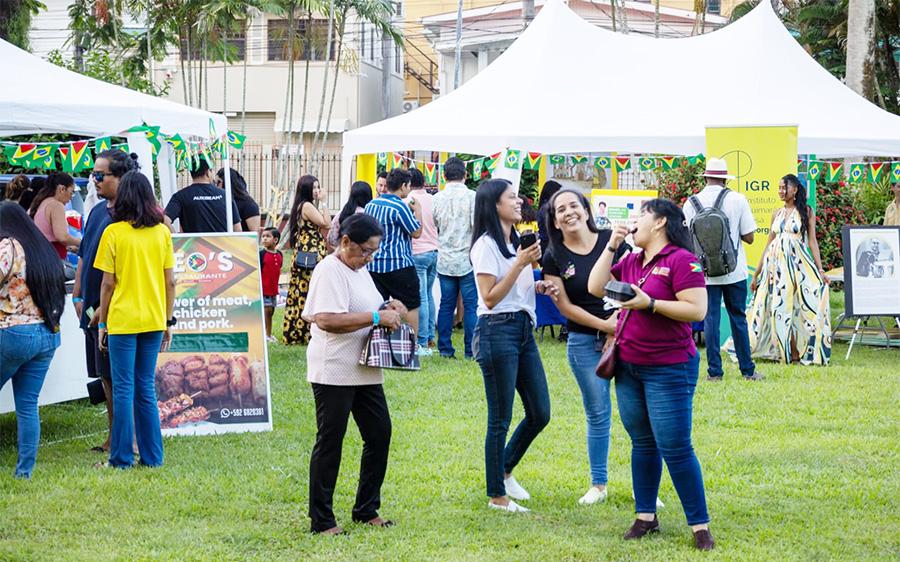
FROM PAGE 13
together, we’ll do it.
You know, where we can become, at least in the region, an exporter of grain to the Caribbean within a very short time,” he further stated.
The government is looking far beyond oil and gas, Fernandes stated, pointing to the positive trajectory of the non-oil sectors.
“I wouldn’t say the government’s focus is solely on oil and gas. Oil and Gas gives us the opportunity to do everything else... But I really think that the government is thinking about multiple things, or having to think about multiple things all at once; so infrastructure development, security, education, health, and then also how to navigate, in an agricultural sense, the world market situations that affect us both positively and negatively from time to time,” he said.
Amidst global challenges, he lauded the government’s ability to keep the country stable, even tracing the administration’s competency to the COVID-19 pandemic.
“The government did a great job of not stopping imports to help service and support these agricultural entities. But we, we as a country, should realise that we are kind of lucky in our ability to provide food for ourselves,” he said.

By Feona Morrison
MERISSA Kassandra Bryan
was officially called to the Bar in a recent ceremony before Justice Sherdel Isaacs-Marcus of the Demerara High Court, marking the culmination of a journey defined by perseverance, faith, and sacrifice.
Her petition was presented by Attorney-at-Law and Legal Adviser of the Guyana Geology and Mines Commission
Kara Duff-Yehudah.
In her speech, Bryan recounted a lifelong aspiration to help others, inspired by her faith and the example of Jesus Christ. She described how, from the age of seven, while attending Josel Education Institute, she felt a calling to defend those in need, a drive that led her to “defend cases” at home from as early as age nine.
Encouragement from her father—who often told her,
“You’re always debating, it’s best you go in the court”—resonated throughout her life.
Bryan’s journey to becoming a lawyer was far from linear.
Despite excelling at the Caribbean Secondary Education Certificate (CSEC) examinations, she initially faced setbacks in gaining entry to the University of Guyana’s law programme due to the lack of Caribbean Advanced Proficiency Examination (CAPE)
qualifications.
She enrolled in a one-year pre-law programme in Communication Studies, finishing with a GPA of 3.0—just below the cut-off for that year. Undeterred, she pursued a Diploma in Communication Studies and continued to apply for admission despite multiple rejections.
She added that she did not give up. She used her diploma to begin legal studies through Nations University, but finan-
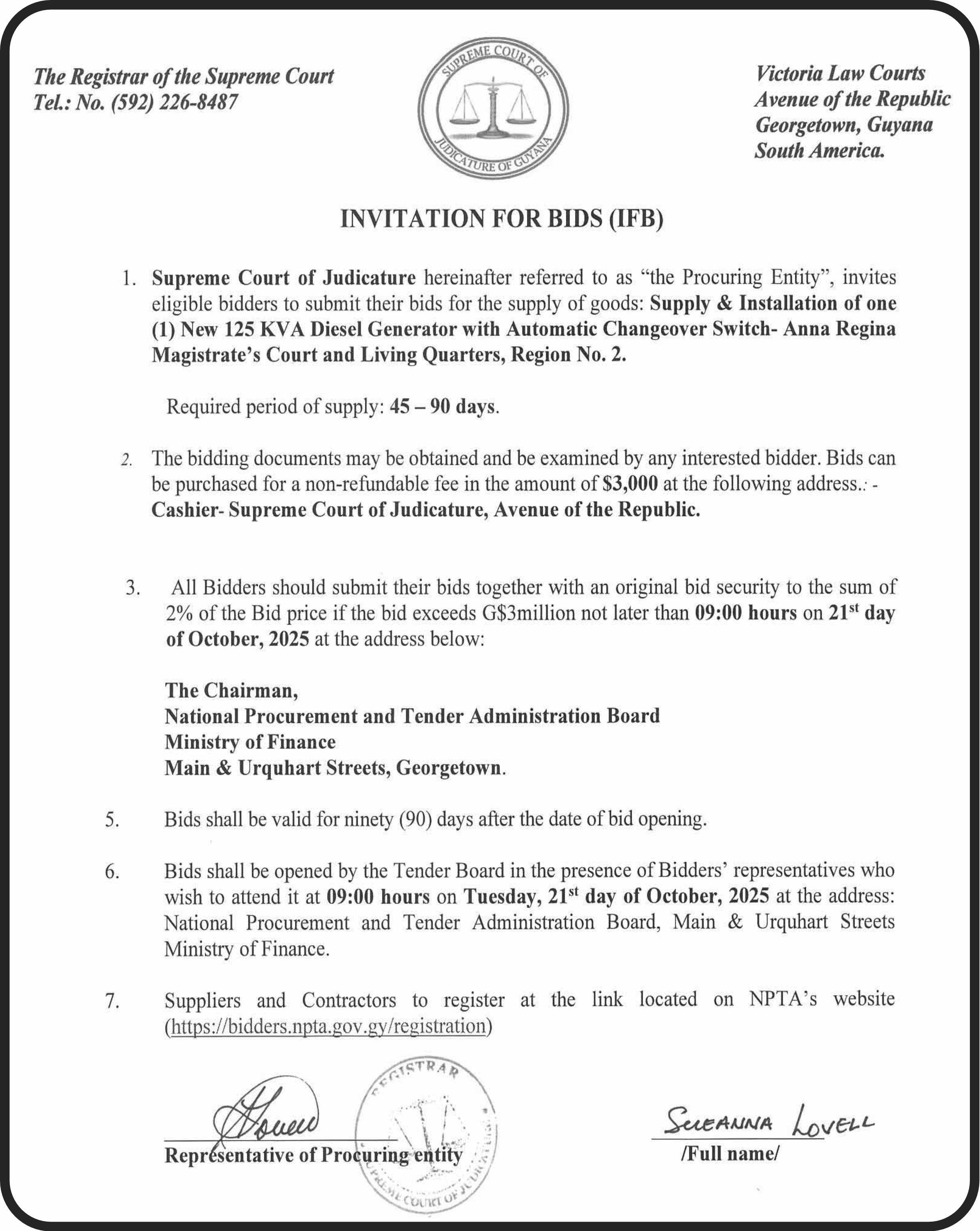
cial constraints forced her to withdraw. She then returned to the University of Guyana to complete her Degree in Communication Studies.
During this time, she battled personal challenges, including a severe heartbreak, financial constraints, and later, pregnancy.
she had to sit a supplemental exam shortly after getting married and later managed to successfully pass six subjects in her final year while her peers completed fewer subjects. She emphasised the lessons of humility, perseverance, and purpose she learned through these challenges.
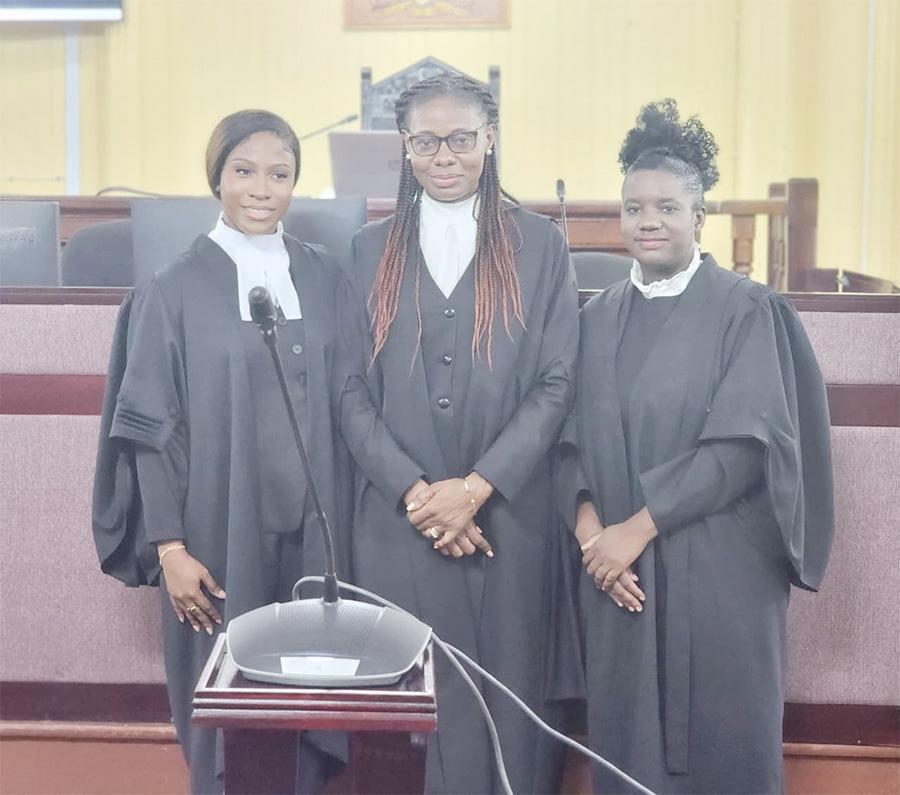
Her father’s illness added further strain. During her final year of studies, he was gravely ill with stage four kidney failure. In the months that followed, she lost him, and three months later, she gave birth to her daughter, Umaya.
Despite these challenges, Bryan completed her degree with credit, earning mostly As and Bs, all while caring for a newborn.
Bryan added that in God’s perfect timing, she was finally accepted into the Bachelor of Laws Programme. Along the way, she also obtained Certification in Advocacy and Evidence for Summary Court Prosecutors, completing it alongside her law degree.
Bryan credited her accomplishments to divine guidance and unwavering family support. She acknowledged her mother’s sacrifices, including providing financial backing, and serving as surety to secure a scholarship for Hugh Wooding Law School in Trinidad and Tobago.
She also thanked her siblings, friends, colleagues, and mentors who supported her throughout the journey. Among them, her sister, Khadija, who was studying medicine, played a crucial role in helping balance motherhood and academics.
She described her experience at Hugh Wooding Law School as demanding, citing the pressures of balancing marriage, motherhood, and rigorous study. At one point,
As Bryan takes her place among Guyana’s legal practitioners, she vows to carry out her duties with humility, integrity, and a commitment to justice. She concluded her speech by reaffirming her dedication to her calling, expressing gratitude to all who walked the journey with her and emphasising her desire to serve faithfully in the legal profession.
In her speech, Bryan expressed her commitment to serve not only as a lawyer but as a “servant of justice, of truth, and of people”. She outlined her interests in corporate law, conveyancing, and family law, noting her desire to advocate for those without a voice, particularly the marginalised and vulnerable.
Bryan’s journey, as she recounted, was guided by faith and perseverance, reinforced by a network of family, friends, and mentors. She invoked Jeremiah 29:11, highlighting her belief in divine purpose and the promise of a hopeful future.
Justice Isaacs-Marcus, in granting Bryan’s petition, emphasised the importance of honesty and integrity in the legal profession. The judge stressed that an attorney must always uphold truthfulness in dealings with the court, clients, and fellow lawyers.
She further stated that based on all she had heard, she had no reason to refuse Bryan’s petition and expressed confidence in her future success as a lawyer.
to his family, each of whom, he said, played an essential role in shaping his life and career.
His father, Deputy Commissioner of Police Ravindradat Budhram, stood as a beacon of integrity and discipline. Fenton recalled one of his most cherished moments being the day he graduated from the University of Guyana alongside his father.
“That moment beautifully represented the spirit of perseverance that has always defined our family,” he shared. “He has taught me that integrity is the foundation of every calling.”
He credited his mother, Laleita Budhram, a teacher by profession, for instilling in him the values of patience and perseverance from childhood, “from the two-times table to the importance of never giving up.”
He also expressed admiration for his younger brother, Joshua, a promising cricketer, to whom he hopes to serve as a role model.
enced and skilled as you are.”
He also recognised Ms. Lake, Ms. O’Brien, and several others at the DPP’s Chambers for their willingness to help him understand the intricacies of criminal law.
His exposure to the Attorney General’s Chambers, under the leadership of Anil Nandlall, SC, also provided him with invaluable insights into the civil law practice.
He credited Mr. Nigel Hawke and Ms. Shoshana Lall for their guidance during his early experiences in the legal field.
Budhram further expressed gratitude to Dr. Rahaman, Justice (ret’d) Carl Singh, and the leadership of the Guyana Police Force for their “quiet but powerful support” throughout his journey.
DISCIPLINE AND ACADEMIC EXCELLENCE
Fenton’s academic path is one of consistent achievement. From excelling at St. Margaret’s Primary School
FROM PAGE 18
In brief remarks to the young attorney, Acting Chief Justice Navindra Singh offered practical advice on professionalism, preparation, and humility.
He underscored the importance of understanding the human element behind every case and maintaining diligence in all professional undertakings.
He reminded Budhram that law is both a science and an art, one that demands not only technical skill but also empathy and ethical strength.
The Chief Justice encouraged him to “always be prepared,” to learn from senior practitioners, and to approach each case as a student of justice.
In closing his address, Budhram vowed to serve the legal profession and his country with the same humility and integrity instilled in him from
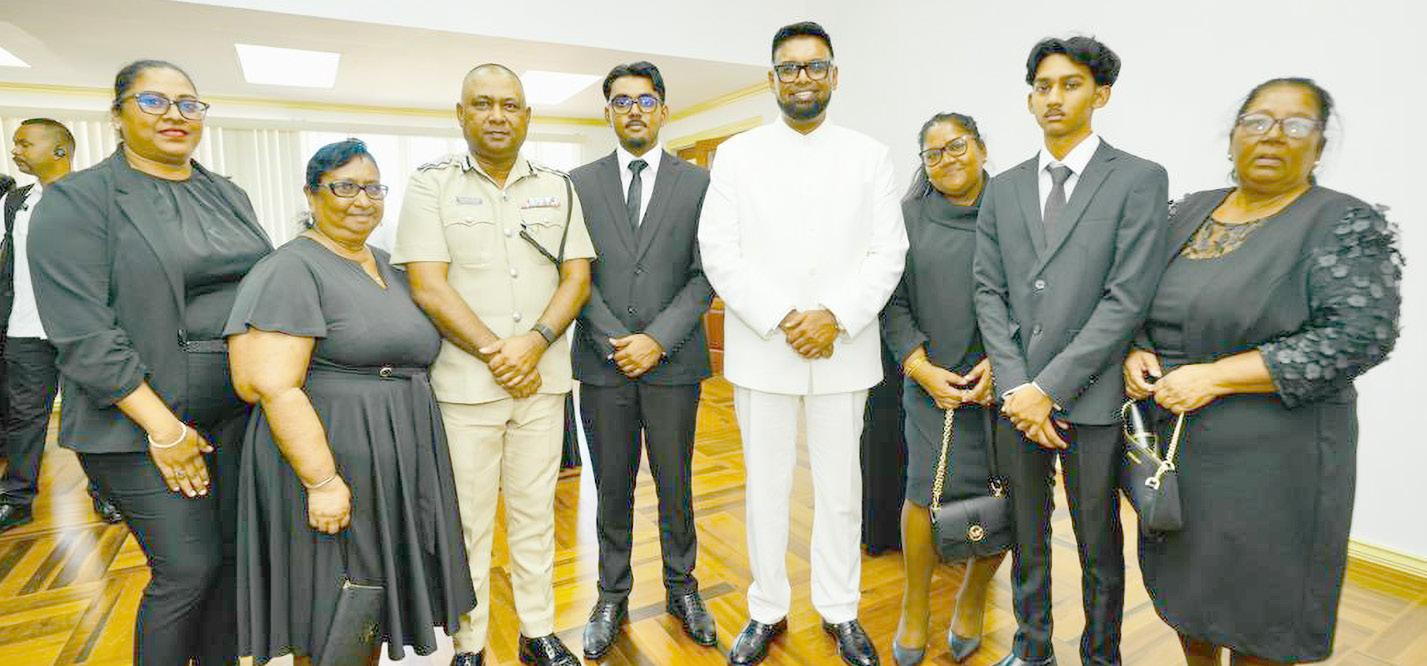
Special thanks were extended to his grandmother, Dorothy Sukhai, affectionately known as “Nanny,” who raised him in his early years and whose “homecooked meals carried with the warmth of the Corentyne countryside.”
He also remembered his late grandfathers, Rajanand Sukhai and Nandlall Budhram, as continuing sources of spiritual guidance.
MENTORSHIP AND PROFESSIONAL GUIDANCE
Budhram’s legal journey was marked by strong mentorship from several distinguished figures. He expressed deep appreciation to Mrs. Shalimar Ali-Hack, SC, who not only presented his petition but also served as a mentor during his in-service training at the DPP’s Chambers.
“Madam DPP has bestowed upon me the realities of the criminal justice system,” he said, acknowledging her guidance in matters of law and public service. “I can only hope one day to be as experi-
and St. Rose’s High, to completing his CAPE studies at The Bishops’ High School, his performance demonstrated both academic excellence and perseverance.
He earned a Bachelor of Laws (LLB) Degree with Distinction from the University of Guyana in 2023 and later pursued his Legal Education Certificate (LEC) at the Hugh Wooding Law School, graduating in October 2025.
During his time at Hugh Wooding, he also served as Secretary of the Hindu Students’ Society and completed ten weeks of in-service training at the DPP’s Office in Guyana.
In a notable chapter of his journey, he served as a police officer in the Guyana Police Force between 2022 and 2023, an experience he said inspired his decision to pursue law.
“At a young age, I saw firsthand the challenges faced by the police and the realities of the justice system,” he reflected. “However, I chose the legal route to play my part in strengthening that system.”
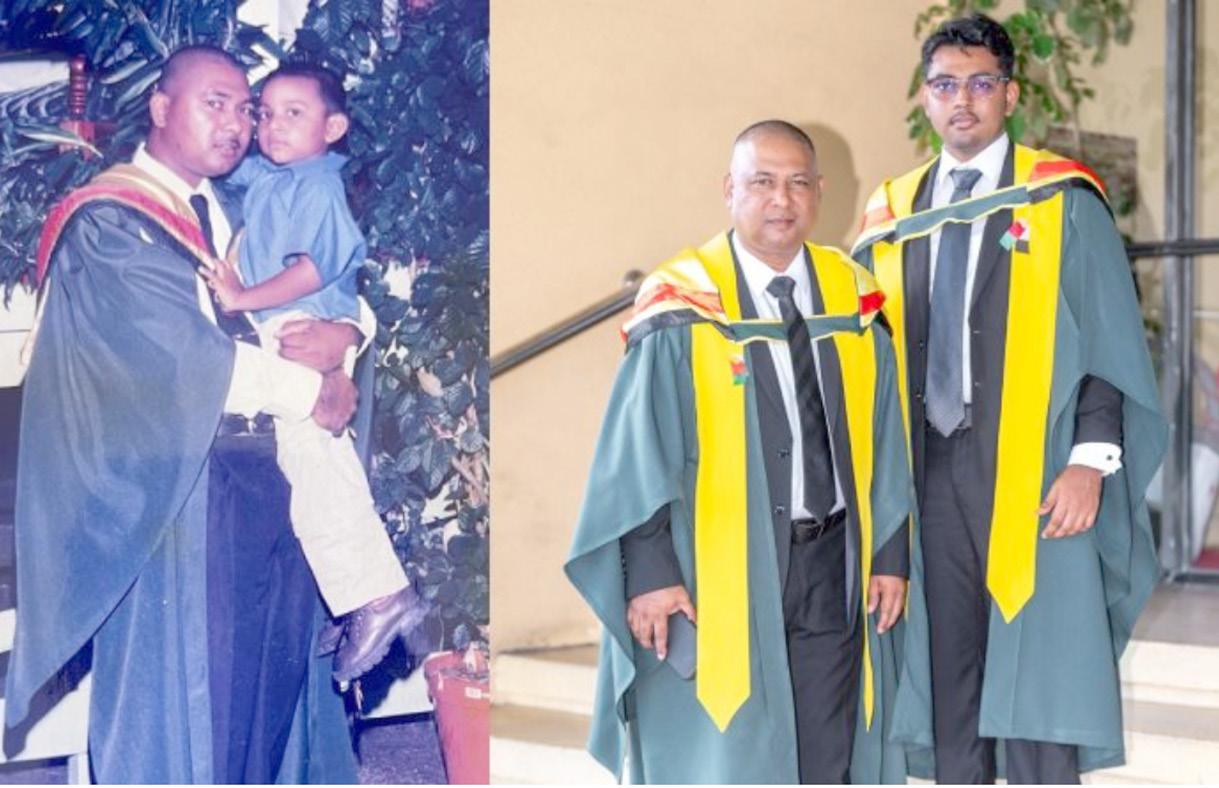
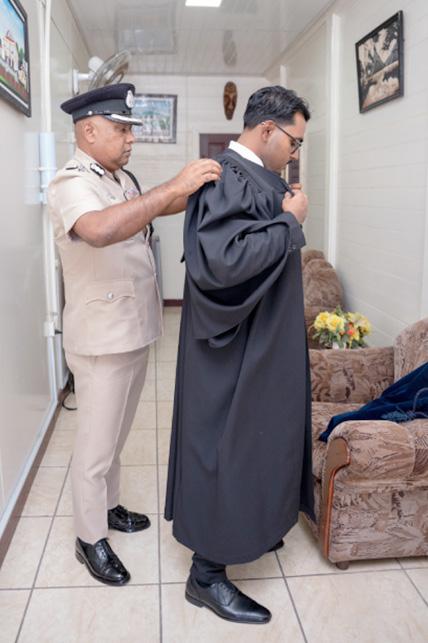
From Left to Right: Mr. Ravindradat Budhram and his son over 20 years ago when he first graduated from the University of Guyana with his son Fenton Budhram. Then in November 2023, the duo made history and celebrated a unique achievement by graduating together from the University of Guyana’s Department of Law. Fast forward to last Thursday Deputy Commissioner Budhram robed his son before his call to the Bar
Police Ravindradat Budhram, whose own academic journey continues to inspire.
In November 2023, during the University of Guyana’s 60th Convocation, the father and son created history when they graduated together from the Department of Law - a moment both described as a shared celebration of perseverance and purpose.
Reflecting on that milestone, Fenton had said, “Graduating alongside my father is memorable because I was inspired by him when I was about four years old; I saw him graduating from the University of Guyana. It was a shared journey of personal growth that continues to be at
the helm of our relationship.”
Deputy Commissioner Budhram, who has served over 30 years in the Guyana Police Force, embodies the spirit of lifelong learning, having earned a Bachelor’s in Public Management, an MBA, and his LLB Degree.
He described the experience of graduating with his son as “the greatest gift a father can enjoy.”
“Education is the key to unlocking one’s true potential,” the senior Budhram remarked at the time. “It is a lifelong journey that knows no age limit or boundaries. Every experience and challenge is an opportunity to learn.”
His dedication to both education and leadership continues to serve as an inspiration, not only to his family but to members of the Guyana Police Force and the wider community, reinforcing the message that growth and service go hand in hand.
From the dining table where a young boy first learned the value of perseverance to the courtroom where he now pledges to uphold justice, his journey reflects the unbreakable bond between parent and child, and the belief that education, when shared across generations, can shape not only lives but the nation itself.
his family and mentors.
“I intend to serve to the best of my ability, with consideration of my overarching duty to this Honourable Court,” he declared. “It would be an honour to serve.”
The admission of Fenton Jonathan Budhram to the Bar is not only a personal triumph but also a story of intergenerational perseverance, discipline, and national pride.
From a dining table that became a classroom of dreams to the courtroom that now bears witness to his first steps as an attorney, his journey stands as an inspiring testament to the power of family, education, and purpose.
As the curtains close on one chapter and open on another, Budhram’s words echo the sentiment of his lifelong philosophy, that every page turned reveals not just a new challenge, but a new opportunity to serve with honour.
Meanwhile, that sense of purpose, humility, and drive to serve is deeply rooted in the values passed down by his father, Deputy Commissioner of

OLD Collin Jackman, also known as “Junior,” pleaded guilty, on Wednesday last, to the 2021 murder of 59-year-old Keith Richard Hohenkirk at Tuschen, East Bank Essequibo.
The plea was entered before Chief Justice (ag) Navindra Singh at the High Court in Demerara.
Jackman, represented by attorney-at-law Madan Kissoon, is scheduled to return to court on November 19, 2025, for sentencing. The prosecution team in the case comprises State Counsel Geneva Wills, State Counsel Christopher Belfield, and State Counsel Simran Gajraj.
According to the statement of agreed facts, the
tragic incident occurred between October 23 and 24, 2021. Around a week prior, Jackman and others had planned to use a psychotropic substance known locally as “molly” to drug and rob Hohenkirk, an amputee.
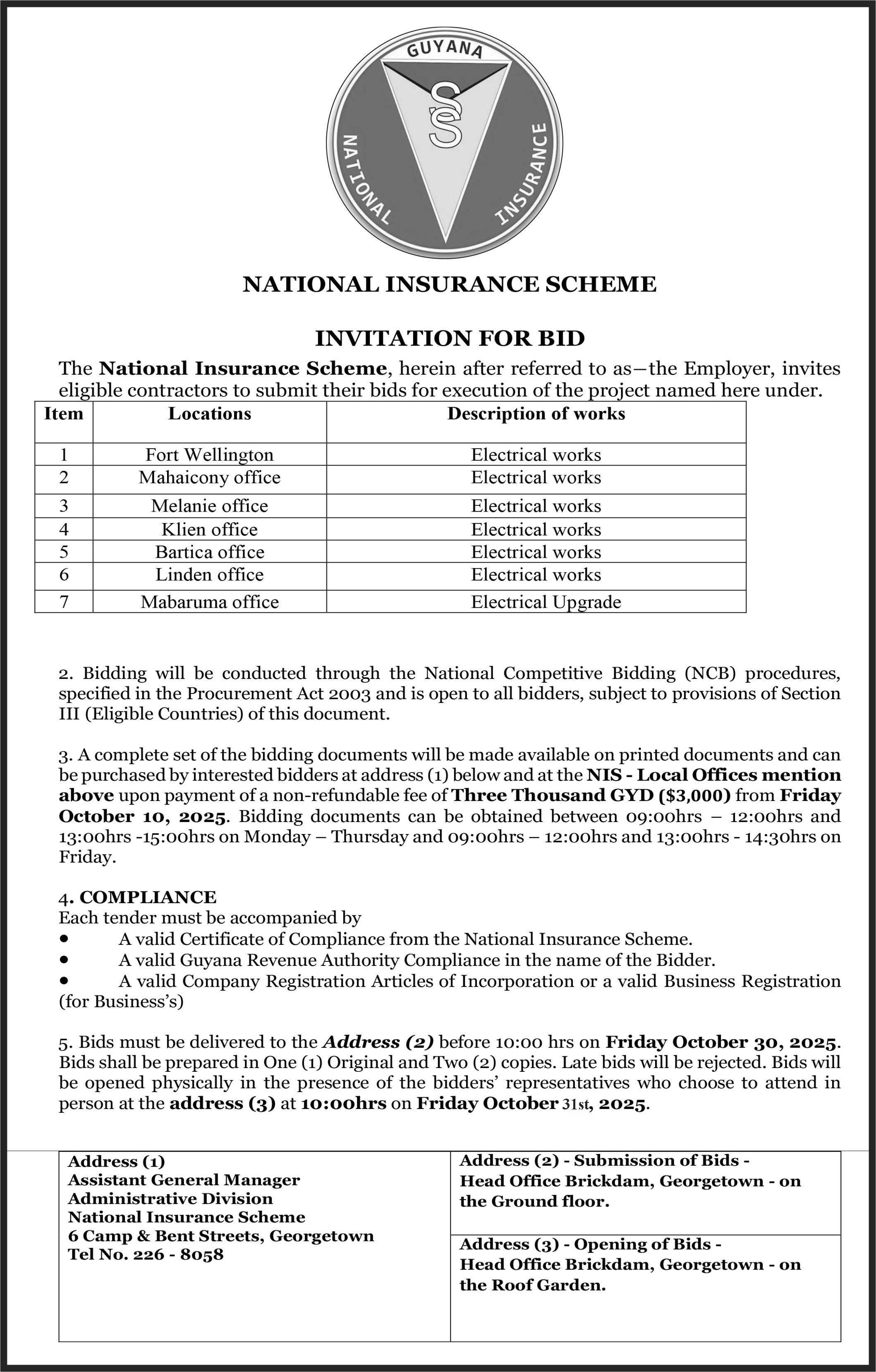
On the night in question, the group met at the now deceased’s residence, consumed the drug, and drank Banko wine. An argument broke out during the gathering, escalating into a violent assault on Hohenkirk.
Jackman, along with others, restrained the victim by tying his hands and feet, gagging him with a rope, and stuffing a rag into his mouth. The convict then struck Hohenkirk three times to the face and head. Another man involved later applied handcuffs to Hohenkirk.
Following the assault, Jackman and his associates ransacked the house and shop, stealing money, snacks and drinks before leaving. Jackman and another accomplice later returned to retrieve the wine bottle and found Hohenkirk motionless and cold, but still proceeded to rob the shop again.
On the morning of October 24, 2021, police discovered Hohenkirk lying on his back with his hands and mouth bound, and the room in disarray. He was pronounced dead at the Leonora Cottage Hospital.
A post-mortem examination conducted by Dr. Nehaul Singh revealed blunt trauma to the head and neck, including subdural hemorrhage and neck injuries. The cause of death was recorded as a subdural hematoma resulting from blunt trauma to the neck. Following his arrest on October 26, 2021, Jackman admitted in a caution statement that he had participated in the plan to drug and rob the now deceased man and had hit him.
During Wednesday’s court proceedings, Chief Justice Singh carefully ensured that Jackman fully understood the gravity of his plea. The proceedings began with the prosecution presenting the indictment for murder
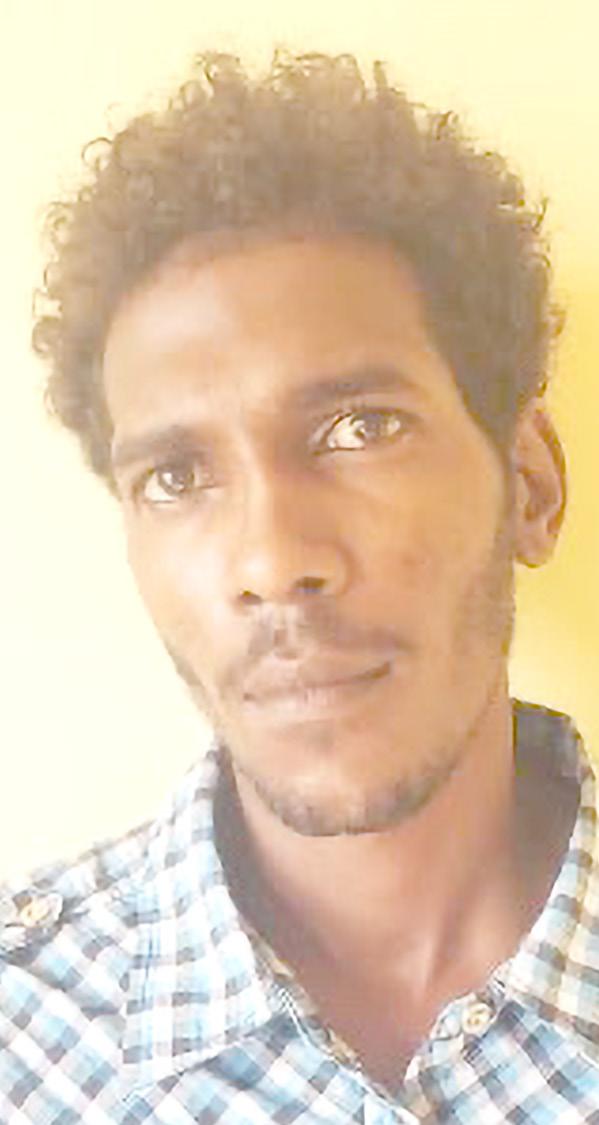
committed in the course of robbery.
Jackman confirmed his identity and understanding of the charges, stating unequivocally that he was pleading guilty. He also acknowledged that he understood he could have opted for a trial before a jury but voluntarily waived that right. The Chief Justice inquired whether Jackman was under the influence of any substances, to which he responded that he had not consumed drugs, alcohol, or medication in a long time. Based on the agreed facts and Jackman’s admission, the court accepted the plea of guilty to felony murder, highlighting that the crime occurred in the course of a joint enterprise. Justice Singh subsequently ordered the preparation of a probation report and a psychiatric assessment for the accused, to be submitted on or before November 5, 2025. Victim impact statements, as well as statements of aggravating and mitigating factors, are also to be laid before the court by the same date. The Chief Justice adjourned the matter to November 19, 2025, for sentencing. At that time, the court will consider all reports and determine an appropriate sentence for Jackman.
Attorney Kissoon confirmed that his client understood the potential maximum sentence of 30 years’ imprisonment and voluntarily chose to plead guilty.
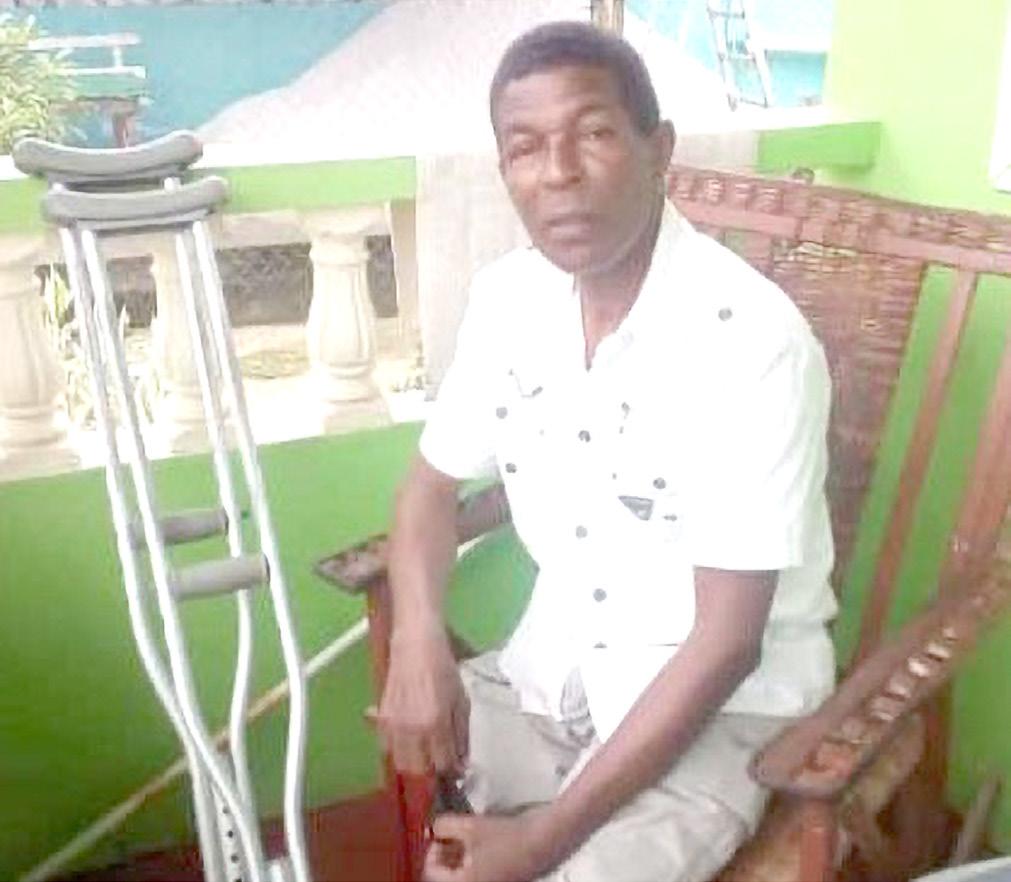
POLICE ranks attached to the Fort Wellington Police Station, on Thursday night, seized approximately 22 pounds of suspected cannabis during a stopand-search operation at Cotton Tree Public Road, West Coast Berbice.
According to the Guyana Police Force, the operation was conducted around 23:40 hours on October 16, 2025. During the exercise, ranks stopped a white Toyota Premio driven by a 43-yearold carpenter from New Amsterdam, Berbice. A 14-year-old from the same area
was also in the vehicle. A search conducted in the presence of both occupants led to the discovery of several bulky, plastic-wrapped parcels concealed inside a speaker box in the car’s trunk. The parcels were found to contain leaves, seeds, and stems suspected to be cannabis.
Police said the driver admitted ownership of the suspected narcotics. The vehicle, drugs, and other related items were seized and lodged as exhibits. Both individuals are in police custody assisting with the ongoing investigation.
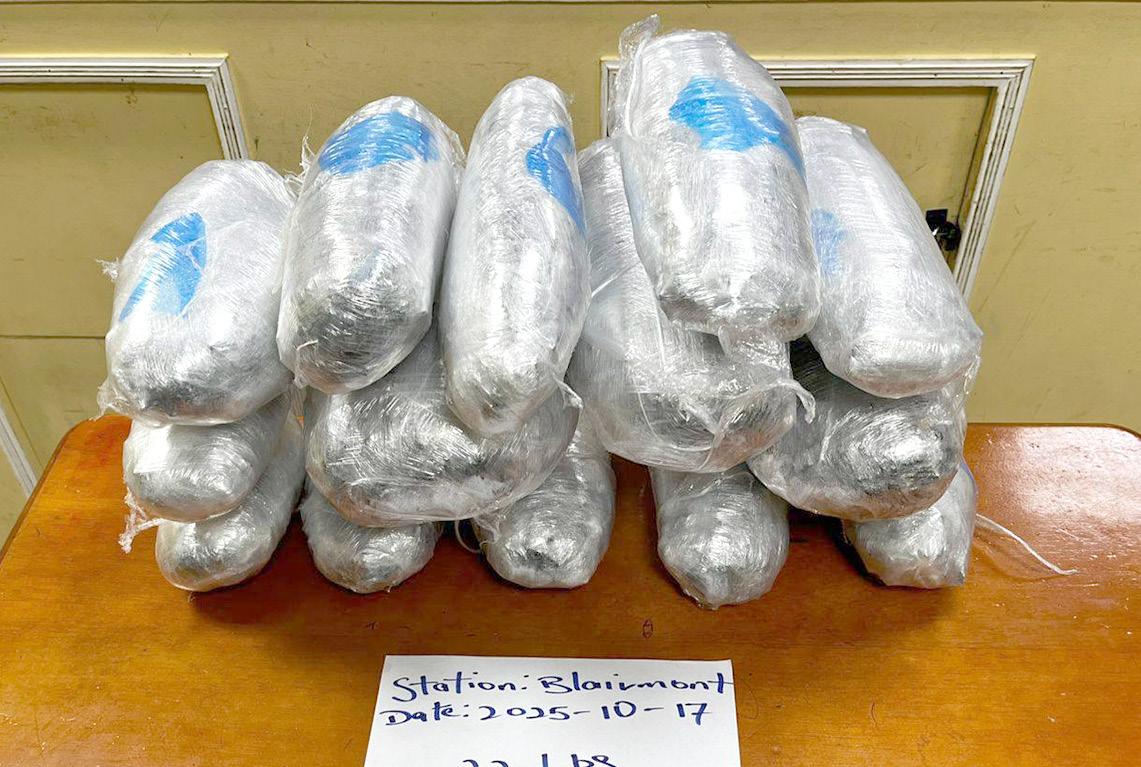
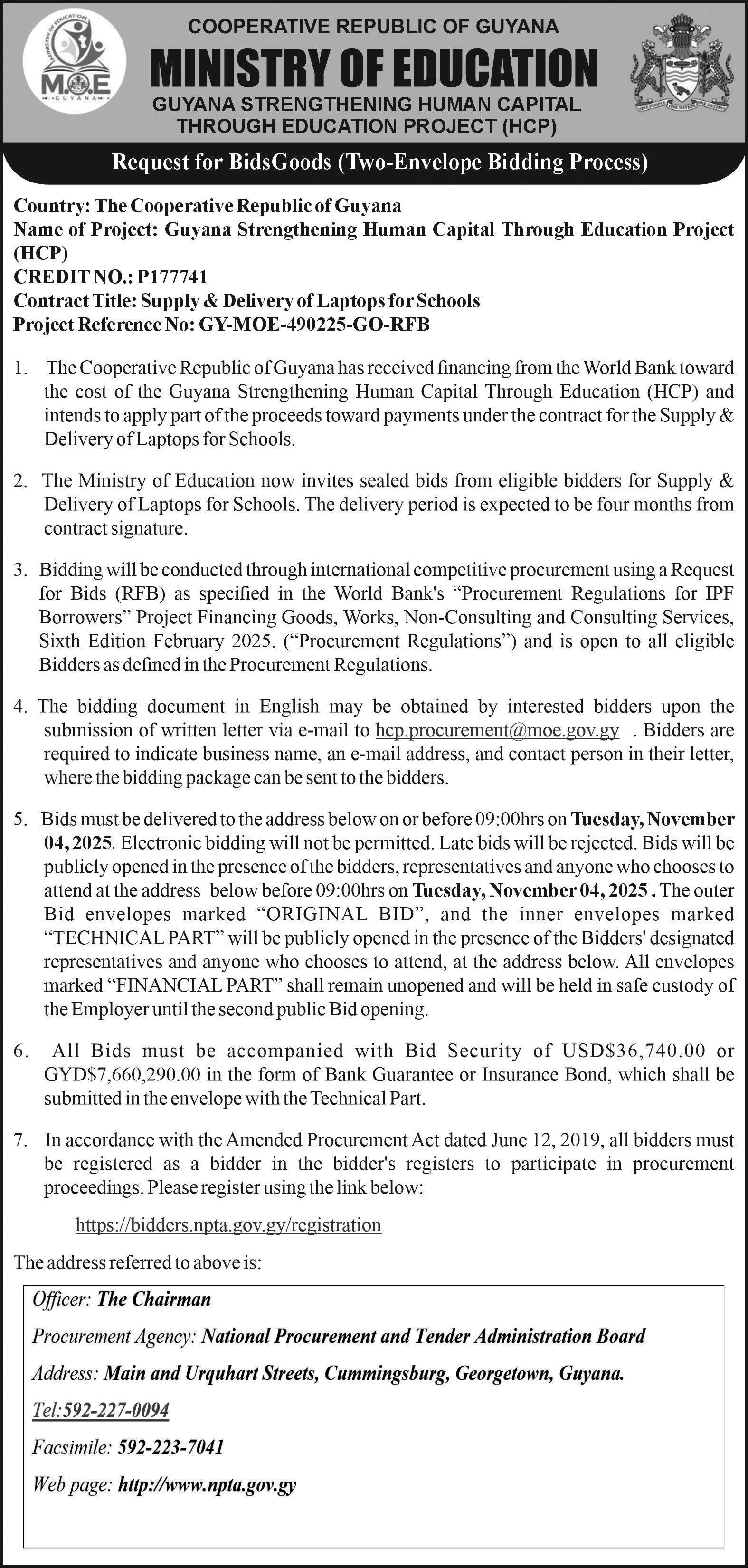
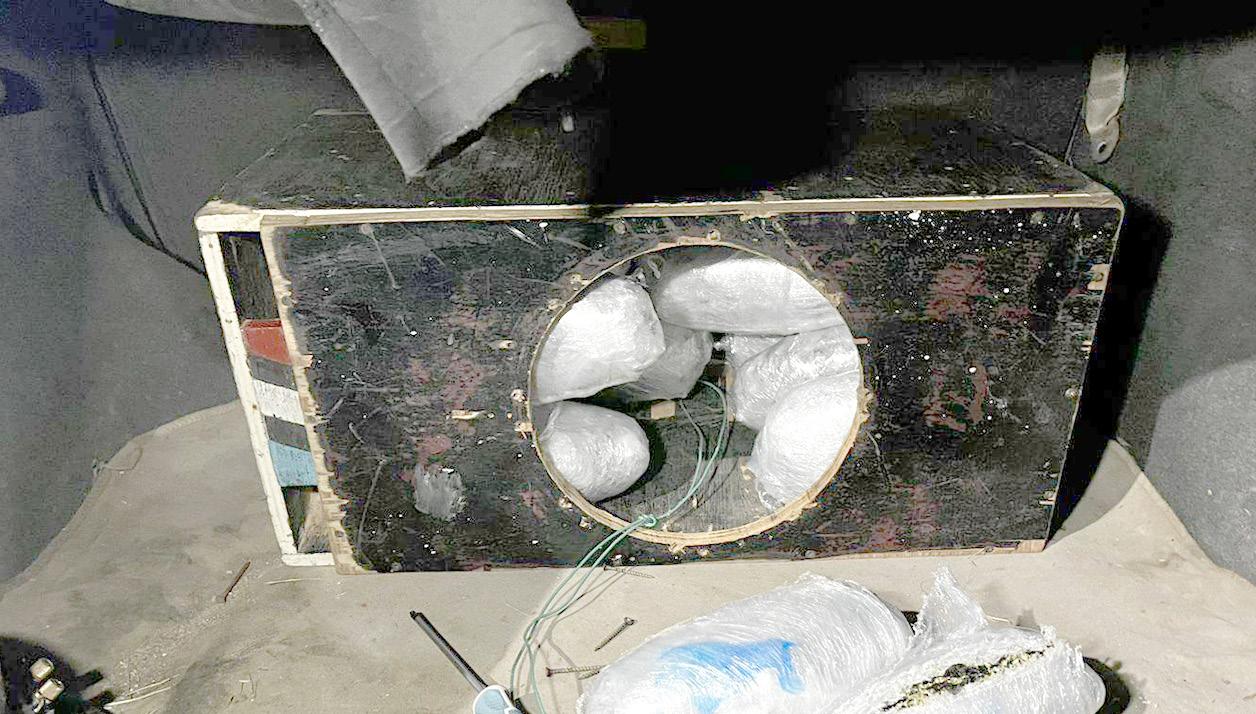
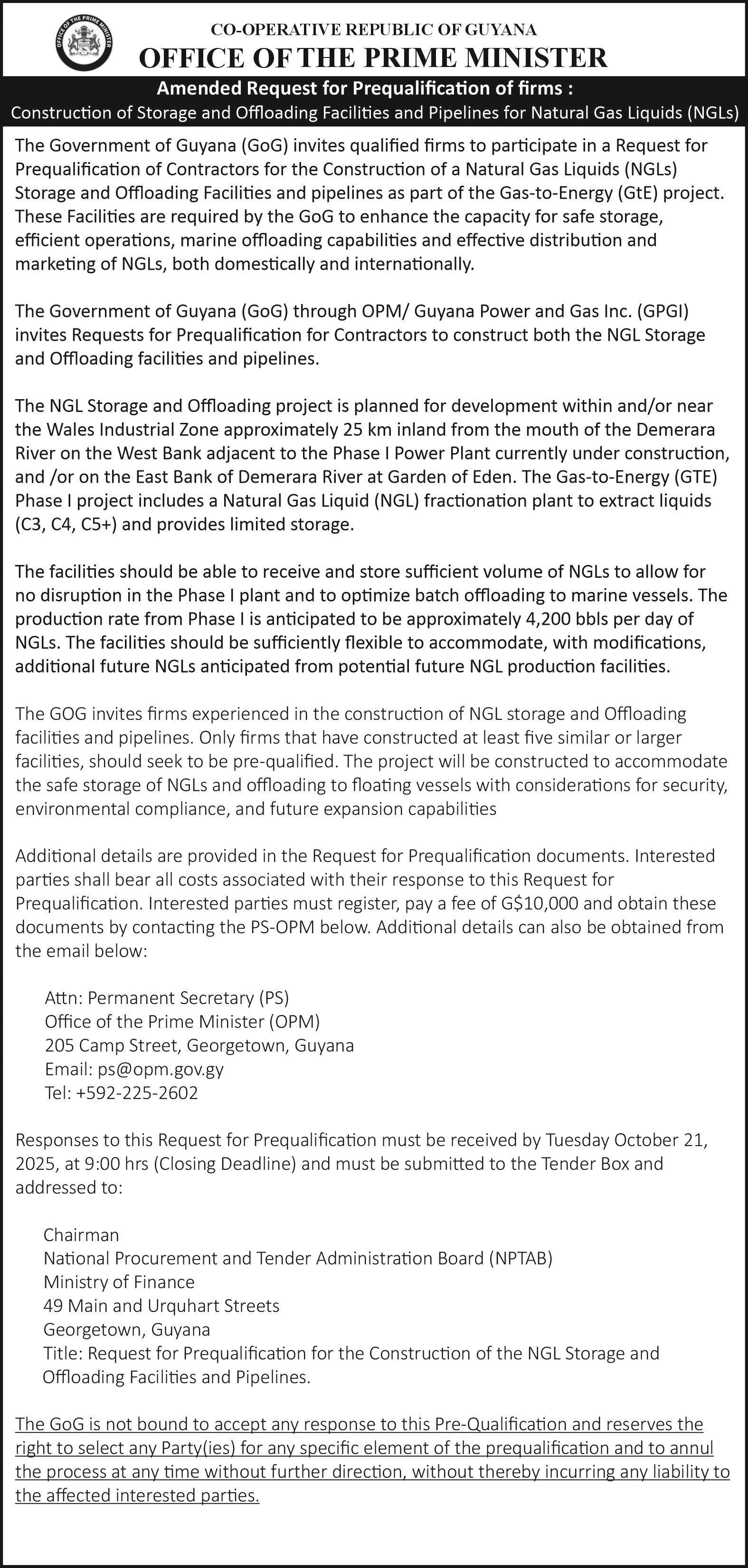



• From Page 32
Skipper Mehidy Hasan Miraz broke the monopoly by accounting for the wicket of Gudakesh Motie lbw and the outcome was essentially settled when captain Shai Hope edged Islam behind to be out for 15 to make the score 118 for seven in the 34th over.
Mustafizur Rahman then picked up the wickets of Romario Shepherd and Justin Greaves in quick succession, before Hossain fittingly ended the match by having last man Jayden Seales caught at slip.
Hossain ended with career best figures of 6-35 from his nine overs, while Rahman took 2-16.
Earlier, captain Shai Hope made the bewildering decision to send Bangladesh in to bat after winning the toss.
They quickly grabbed the initiative when Romario Shepherd trapped Saif Hassan lbw and Jayden Seales had Soumya Sarkar caught at backward point to leave the home side in trouble at eight for two.
However, Towhid Hridoy, who
BANGLADESH
Saif Hassan lbw b Shepherd 3
Soumya Sarkar c Chase b Seales 4
Najmul Hossain Shanto lbw b Pierre 32
Towhid Hridoy c +Hope b Greaves 51
Mahidul Islam Ankon b Chase 46
*Mehidy Hasan Miraz c Greaves b Chase 17
+Nurul Hasan c Pierre b Greaves 9
Rishad Hossain b Seales 26
Tanvir Islam not out 9
Taskin Ahmed c Athanaze b Seales 0
Mustafizur Rahman run out 1
Extras (lb3, w6) 9
TOTAL (all out; 49.4 overs) 207
Fall of wickets: 1-8, 2-8, 3-79, 4-115, 5-158, 6-165, 7-182, 8-198, 9-198, 10-207.
Bowling: Seales 7-0-48-3, Shepherd 7.4-1-311, Pierre 10-2-19-1, Chase 10-0-30-2, Motie 10-0-44-0, Greaves 5-0-32-2.
topscored with 51 and Najmul Hossain Shanto, who made 32, came to their side’s rescue in a 71-run partnership for the third wicket.
Mahidul Islam Ankon also scored a crucial knock of 46, while Hossain lashed 26 runs from 13 balls that helped
WEST INDIES
Brandon King c +Hasan b Hossain 44
Alick Athanaze lbw b Hossain 27
Keacy Carty c Hassan b Hossain 9
*+Shai Hope c +Hasan b Islam 15
Sherfane Rutherford c +Hasan b Hossain 0
Roston Chase c +Hasan b Hossain 6
Gudakesh Motie lbw b Miraz 3
Justin Greaves c Hassan b Rahman 12
Romario Shepherd c Miraz b Rahman 1
Khary Pierre not out 7
Jayden Seales c Miraz b Hossain 3
Extras (lb3, w3) 6
TOTAL (all out; 39 overs) 133
Fall of wickets: 1-51, 2-79, 3-82, 4-82, 5-92, 6-100, 7-118, 8-121, 9-122, 10-133.
Bowling: Ahmed 2-1-10-0, Islam 10-1-46-1, Rahman 5-0-16-2, Miraz 10-3-16-1, Hossain 9-0-35-6, Hassan 3-0-7-0.
Player-of-the-Match: Rishad Hossain.
Bangladesh pass the 200-mark.
Seales was the West Indies’ best bowler with 3-48, while Chase (2-30) and Greaves (2-32) provided good support.
The second ODI is scheduled to be played on Tuesday.
Mohammad Rizwan’s position as Pakistan’s ODI captain is in serious doubt after the PCB said it had “yet to finalise a captain” for the upcoming series against South Africa. The board confirmed that white-ball head coach Mike Hesson had called a selection committee meeting to decide the ODI leadership. Notably, the statement made no mention of Rizwan, who was appointed last year and led Pakistan to ODI series wins in Australia, Zimbabwe and South Africa.
However, results in 2025 have been disappointing, including defeat in a home tri-series final to New Zealand, an early Champions Trophy exit, and an away series loss to the West Indies. Despite the speculation surrounding him, no cricketing reason has been cited for placing Rizwan’s role in jeopardy. His individual form remains solid — he is Pakistan’s second-highest ODI run-scorer this year with 361 runs at over 36, and he recently made 75 in a 163-run Test stand with Salman Ali Agha against South Africa.
While Rizwan has not officially been removed, the statement suggests his exit is imminent. It mirrors the treatment of Shaheen Shah Afridi, who was removed as T20I captain shortly after Mohsin Naqvi became
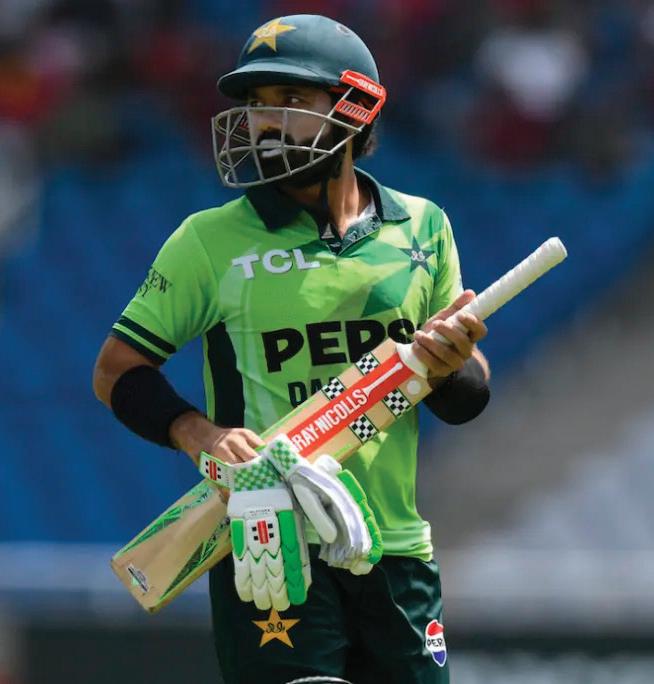
PCB chairperson. At the time, Naqvi refused to confirm Afridi’s future, saying a long-term solution was needed. Shaheen was replaced by Babar Azam a week later, sparking controversy when the PCB issued a statement in his name that he denied approving. Hesson has no formal role in appointing captains, yet his influence appears significant.
The selection committee will meet Monday, with a decision expected soon. (ESPN Cricinfo)
Pakistan’s results under Mohammad Rizwan have dwindled despite his form not dropping off • ( AFP/Getty)

Sunday, October 19th, 2025
AFGHANISTAN Cricket Board (ACB) announced on Saturday that they have decided to withdraw from participating in the upcoming Tri-Nation T20I Series involving Pakistan, scheduled to be played in late November.
Afghanistan was scheduled to travel to Pakistan to play a tri-series involving Sri Lanka and the hosts from November 17.
ACB stated that they have taken the decision to postpone their scheduled tour to Pakistan in response over the tragic martyrdom of the brave cricketers from Urgun District in Paktika Province, who were targetted on Friday (October 17) evening in an attack.
Their players (Kabeer, Sibghatullah and Haroon) alongside five other fellow countrymen from Urgun District were martyred, and seven others were injured. The players had earlier traveled to Sharana, the capital of Paktika province, to participate in a friendly cricket match.
“In response of this tragic incident and as a gesture of respect to the victims, the Afghanistan Cricket Board has decided to withdraw from participating in the upcoming Tri-Nation T20I Series involving Pakistan, scheduled to be played in late November,” ACB said in a statement.
“The Afghanistan Cricket Board expresses its deepest sorrow and grief over the tragic martyrdom of the brave cricketers from Urgun District in Paktika Province, who were targetted this evening in a cowardly attack carried out by the Pakistani regime,” it said.
The ACB considers this a great loss for Afghanistan’s sports community, its athletes, and the cricketing family. The ACB also extends its deepest condolences and solidarity to the bereaved families of the martyrs and to the people of Paktika Province,” it added.
Left-arm fast bowler Fazalhaq Farooqi in his official Facebook page stated that the act was heinous.
“The martyrdom of the civilians and our domestic cricket players by the oppressors is an unforgivable crime,” said Farooqi.”The massacre of innocent civilians and our domestic cricket players by these oppressors is a heinous, unforgivable crime,” it said.
It remains to be seen whether Afghanistan players shake hand with Pakistani cricketers in the ICC events as many feels it is highly unlikely taking the present relationship prevailing between the two countries. (Cricbuzz)

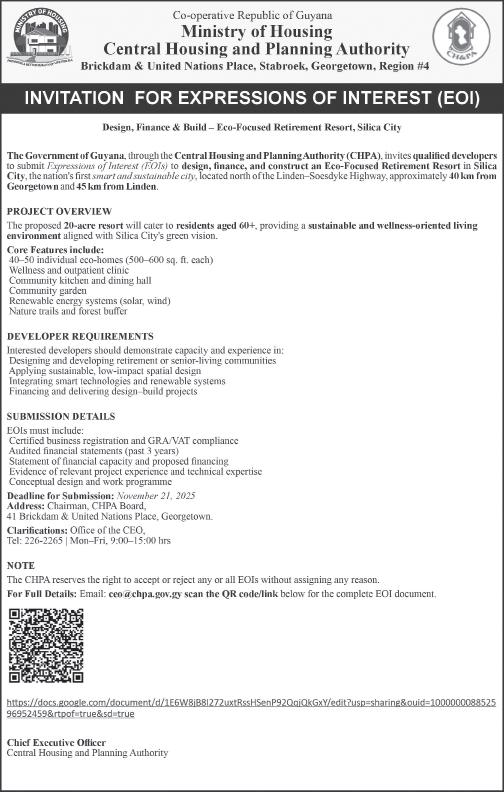

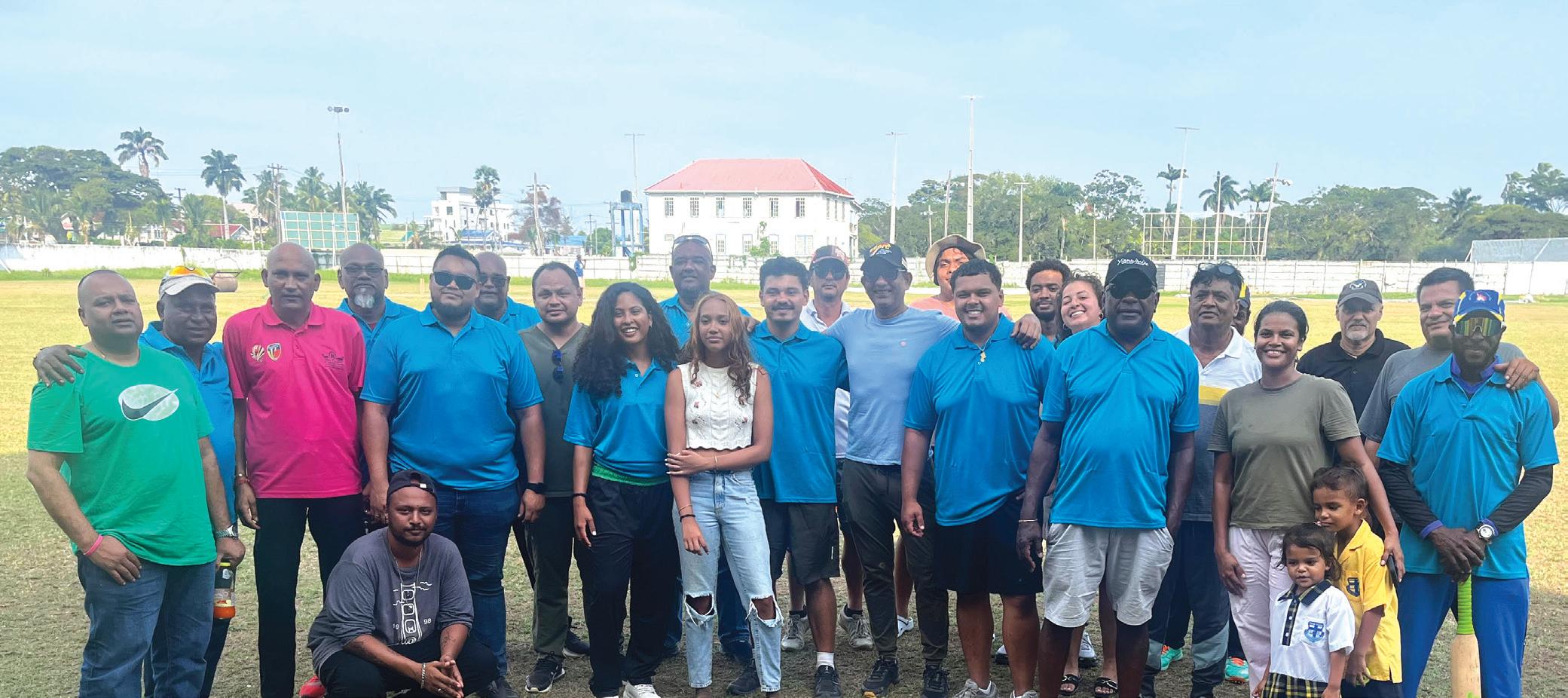
AJIT Agarkar, the chairman of Indian men’s selection panel, stated on Friday that Mohammed Shami was not selected for India’s tour of England due to fitness issues.
However, even as Shami was left out of India’s ODI squad for the upcoming tour of Australia, Agarkar mentioned that he continues to be in the plans if the selectors are convinced of his fitness levels.
Agarkar’s comments came a few days after Shami had expressed his displeasure at not being considered in the national team despite playing four-day cricketin Duleep Trophy and Ranji Trophy.
THE Georgetown Cricket Club (GCC) Select X1 made light work of Homeboyz in their feature 15-over softball encounter, played at Bourda last Wednesday.
Set 81 for victory, after restricting Homeboyz reached 80 for eight in their allotted overs, the GCC Select side comfortably reached the requited target in 10.2 overs.
The experienced Rawle Reid led the way for the winners, spanking six fours in an undefeated 34 while Mark France was undefeated on 28, with four fours, when victory was achieved.
Earlier, skipper Onkar Singh top scored for Homeboyz with 22 before retiring. Bowling for GCC, Eon Gouveia took three for 12 and Christina Bazil two for 23.
The game was the brainchild of
USA-based Guyanese cricket commentator Onkar Singh, who is celebrating 25 years “behind the mike.”
The Homeboyz side included several overseas-based Guyanese residing in the USA and England and the game was played in a very cordial atmosphere.
Regal Stationery & Computer Centre and Trophy Stall also played an integral part in the feature match.

Shami, who is currently playing for Bengal in the opening round of Ranji Trophy 2025-26 at Eden Gardens, picked up three lower order wickets in the first innings against Uttarakhand. In the second essay, he has gone wicketless so far in the 15 overs he has bowled.
“Selection is not in my hands. If there’s a fitness issue, I should not be here playing for Bengal. I don’t need to speak on this and create a controversy. If I can play four-dayers, I can also play 50-over cricket,” Shami told PTI.
Reacting to the statement, Agarkar said at the NDTV World Summit 2025, “If he says that to me, I will probably answer that. I mean if he was here, I would probably do that. I am not quite sure what he said on social media. Maybe if I read that, I might give him a call but my phone is always on for most players. I have had multiple chats with him over the last few months, but I don’t want to try and give you a headline here.
“He has been an incredible performer for India. If he said something, maybe that is a conversation for me to have with him or him to have with me. But even before England, we said if he was fit, he would have been on that plane. Unfortunately, he wasn’t.” (Cricbuzz)
a stubborn
and move three points clear at the top of the Premier League.
Mikel Arteta came into the match without captain Martin Odegaard and named Eberechi Eze in his place as the manager looked to make the most of the attacking talent at his disposal.
However, it was the home side who started brightest and Fulham went close through Harry Wilson and Josh King, who had an effort tipped over the bar by David Raya.
Arsenal grew into the game and Riccardo Calafiori had an excellently worked goal ruled out for offside.
The Gunners started the second half with more intensity and pinned Fulham back for large parts.
That pressure told in the 58th minute when centre-back Gabriel flicked on a Bukayo Saka corner and Trossard was well positioned to fire home from close range at the back post.
Saka thought he had won a penalty to give Arsenal the chance to double their lead, but the decision was overturned by the video assistant referee (VAR).
The victory means Arsenal move three points clear of second-placed Manchester City - who were top for a couple of hours on Saturday after beating Everton - with Liverpool four behind in third. Arne Slot’s side host Manchester United on Sunday (16:30 BST). (BBC Sport)
LOS Angeles Lakers star, LeBron James, will miss nearly a month before making his 2025-26 season debut. James, 40, is reportedly looking at a mid-November return after being diagnosed with sciatica, per ESPN’s Shams Charania.
Both the Lakers and James are targeting mid-November as a possible return date for the 21-time All-Star.
After sitting out during training camp due to glute pain, James was diagnosed with sciatica in early October.
The team said it would re-evaluate James after 3-4 weeks. Charania outlined October 30 as a key date in James’ return, as it marks the earliest possible date the Lakers would re-evaluate James’ recovery.
Sciatica is pain that travels down the sciatic nerve, often the result of a herniated disc. The sciatic nerve runs from the lower back, through the glute and down the leg.
James reportedly sustained the injury during an on-court workout in late July or early August, per Charania. James will re-
portedly take a cautious approach as he rehabs from the issue.
James, who will be 41 in December, is still considered one of the best players in the NBA despite his age. Last season, he averaged 24.4 points, 8.2 assists and 7.8 rebounds with the Lakers.
With James sidelined, Luka Dončić will be tasked with carrying a heavier workload to open the season.
Dončić spent the offseason trying to cut weight to be in better playing shape when the season begins.
His conditioning and hard work will be put to the test immediately with James out to start the year.
Dončić is more than capable of carrying that responsibility while James is on the shelf. Dončić, 26, averaged 28.2 points, 8.2 rebounds and 7.7 assists last season.
If James is able to return around mid-November, he would miss roughly 12 to 14 games to open the 2025-26 NBA season. (Yahoo Sport)
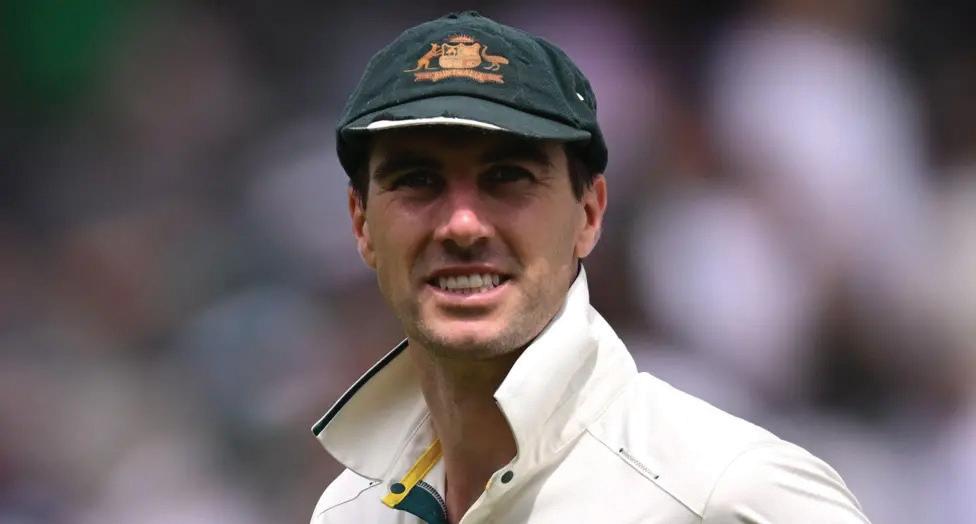
AUSTRALIA captain Pat Cummins will play a “major part” in this winter’s Ashes series against England, says chair of selectors George Bailey.
There had been speculation the 32-yearold could miss the series because of a back stress problem which had not yet healed.
Australia’s camp previously indicated no call has been made on Cummins’ participation, with the five-Test series starting on 21 November in Perth.
Bailey said Cummins is “building up” and was “optimistic” about his chances.
“We know time is getting short and there’s permutations around that, not just around the back, but other factors as well,” Bailey said.
“It’s positive. [We are] really confident that he’s going to play a major part. Hopefully it’s the first Test. If not, then we’ll pick it up.”
Cummins was ruled out of Australia’s limited-overs series against New Zealand and India last month after scans revealed a lumbar bone stress in his back.
He has a history of back injuries, with flare-ups in 2012-13, 2013-14 and 2015-16 causing him to miss three Australian summers
in four years.
He said he would be “aggressive” and “take risks” in his recovery in order to play in the Ashes. Bailey said he did not know if Cummins had begun bowling as part of his rehabilitation but that it was “getting tight” for him to be fit for the first Test.
Should Cummins not be fit in time for the opener in Perth, former captain Steve Smith will skipper the side.
All-rounder Cameron Green was recently pulled out of Australia’s squad for their one-day international series against India as a precaution because of soreness in his side.
Bailey described it as a “minor” injury and said Green will play in the Sheffield Shield, so will be “in a good place to be ready to bowl”.
“We put so much time and energy into building out the plan for him to be available for the first Test as an all-rounder,” Bailey said.
“He was only going to play the first two ODIs anyway. The way he swings the cricket bat in white-ball cricket, even if it just sets him back for 24 more hours, we just made the decision to approach this more conservatively.”

ENGLAND bowling consultant Tim Southee is “still working through” what his involvement will be for the upcoming Ashes series in Australia.
The former New Zealand seamer is only likely to be available for the first Test because of his participation in the International League T20 tournament, which begins on 2 December in the United Arab Emirates.
Southee, 36, was appointed England’s fast bowling consultant in May after taking 391 wickets in 107 Tests for the Kiwis.
Speaking as England’s team for the first of three T20 matches against New Zealand was named, Southee said of his availability: “We’re still working through that at the moment.
“We’ll see what happens over the next little while.”
England bowling legend Stuart Broad has declared the Australia side to be their “worst team since 2010”, but Southee was in little doubt over what to expect during the series, which starts on 21 November.
“I don’t think there’s ever a bad Australian cricket team,” Southee said.
“Our focus is firmly on what we’re trying to do. I think the quality of [England’s] side that’s going out to Australia is brilliant.
“It should be an absolute cracker, that series. Not only [are] English and Australian people looking forward to it, I think the whole cricket world is.”
England white-ball captain Harry Brook has said he is managing to avoid the pre-Ashes discourse, which has included former Australia opener David Warner claiming the tourists are more concerned with “moral victory” than the series result.
Brook says his and England’s “main fo-
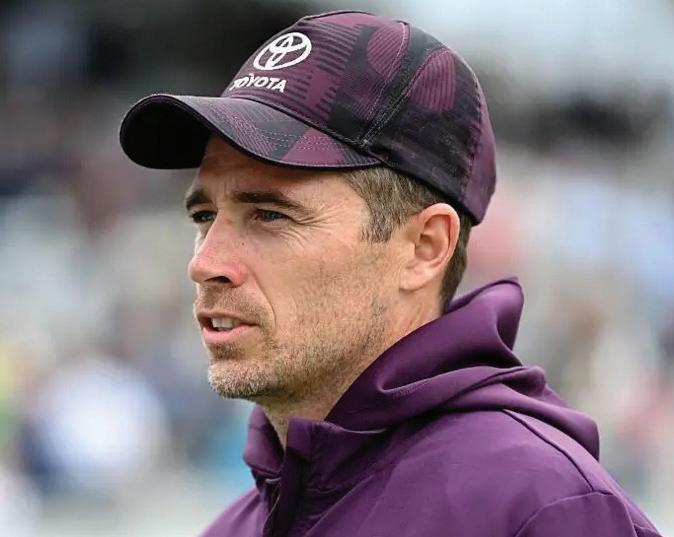
cus” for now is the white-ball series against New Zealand, which begins in Christchurch on Saturday and is an important step towards next year’s T20 World Cup.
“I haven’t seen any of [the Ashes talk]. We’ve got an extremely strong New Zealand side coming up and that’s the main focus at the minute,” Brook said.
“We’ve got a hell of a long winter, so I’m just concentrating on the first game here in New Zealand.
“With the bigger picture being the T20 World Cup, there’s lots of areas that we can improve on. There’s lots of areas we can keep on getting better at, so it’s just about continuing that momentum, playing together as a group, and heading in the same direction.” (BBC Sport)
PAKISTAN are on the brink of elimination from the World Cup after their match against New Zealand was abandoned because of rain.
The tournament’s bottom side are yet to win in five games, and suffered their second successive abandonment in Colombo.
In contrast to the first abandoned match, where they were well placed to beat England, Pakistan were struggling in this fixture, finding themselves at 92-5 at the 25-over mark, after which the covers came on for good.
The R. Premadasa Stadium is playing host to all of Pakistan’s fixtures and the majority of Sri Lanka’s, but Colombo has been blighted by rain, with this match the fourth of nine staged there to fail to reach a result.
The abandonment means an India win against England on Sunday will ensure Pakistan cannot qualify for the knockout stages despite having two group games left to play.
Even if England are victorious, Pakistan will still need to defeat both South Africa and Sri Lanka and hope a large number of fixtures fall in their favour.
Meanwhile, New Zealand move level with India, who occupy the fourth knockout spot, on four points but having played one game more, with the two
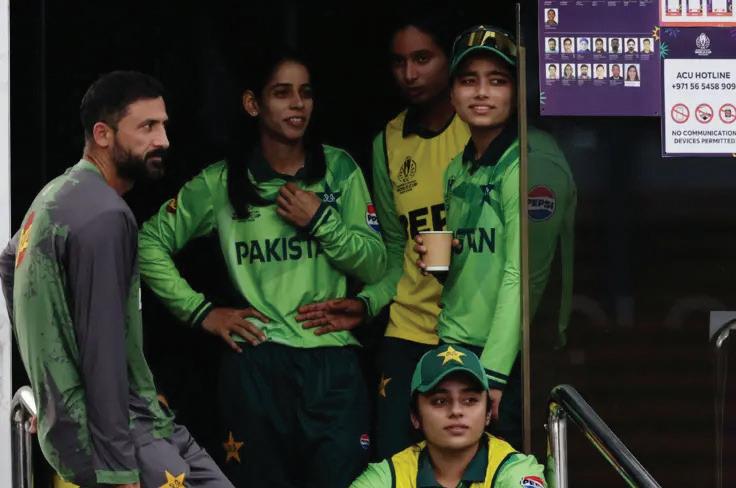
sides set to meet on Thursday. Sophie Devine decided her side would bowl after winning the toss, and New Zealand removed openers Omaima Sohail and Muneeba Ali in the space of four balls to leave Pakistan 30-2 in the seventh over.
Sidra Amin then cut straight to Eden Carson off Lea Tahuhu, with the players coming off for rain immediately
afterwards. Resuming after 90 minutes on 52-3, Natalia Parvaiz holed out to Devine off Carson’s bowling, while Melie Kerr bowled Fatima Sana.
Aliya Riaz, top-scorer with an unbeaten 28, began to rebuild with Sidra Nawaz, but the umpires were forced to call the covers on again and, after almost three hours of waiting for the rain to subside, the match was abandoned. (BBC Sport)
IT was the only time Shubman Gill uncrossed his arms in the 10 or so minutes he stood addressing the media on the Matilda Bay waterfront.
And it came at the very end of his press conference on the eve of the first ODI. After having spent all that while with his hands tightly folded across his chest, he let them drop before casually slipping them into his pockets. It was also the first time on Saturday afternoon that the new India 50-over captain was asked about his own batting.
Till that point, most of the questions had somewhat and somehow gravitated back to Gill’s immediate two predecessors. Both of whom, Rohit Sharma and Virat Kohli, will be playing their first match for India in over eight months on Sunday. Both of whom have now retired from all other formats.
This is not to suggest that Gill’s body language meant he was holding back in any way when it came to talking about Rohit and Kohli. Whether it was him raving about the privilege of captaining two of the most successful ODI cricketers of all time. Or getting to pick their brains as leaders in the lead-up to his first go at leading an Indian team in this format. But it just was too obvious not to mention how much more relaxed he

seemed to be when Gill did get the opportunity to talk about Shubman Gill. In a way it seemed apt too. This is officially the start of a new era for India in ODI cricket. But whether it’s in the way the series has been promoted or the way it’s been sold, the overwhelming narrative has surrounded the two modern-day behemoths of Indian cricket.
Almost to the extent that it’s overshadowed most other storylines going into the opening game, across both dressing-rooms for that matter. You are after all talking about the most prolific century-maker in ODI history and another giant of the format, who’s scored three ODI double

PRECISION Sports is an organisation actively involved in the promotion of female cricket in Guyana. In response to the founder of the organisation, Nidia Andrews, “Project Cricket Gear for young and promising cricketers in Guyana, “ has donated one box of cricket balls which were used in a recently concluded tournament which involved top female cricketers from the three counties of Guyana.
hundreds for good measure.
And with the next 50-over World Cup still two years away, the overall relevance of this three-match series does not match up with the five T20Is that will follow right after. Considering how close we are to the next World Cup in the shortest format.
More reason for the focus to likely remain entrenched on Kohli and Rohit over the next week or so. From picking up signs as to whether they could push on till 2027 or even getting used to seeing them in India colours again after what seems like a lengthy break, especially when you consider how significantly the duo have in large ways defined the last 15 years of Indian cricket. (Cricbuzz)
Probable XI: Travis Head, Mitch Marsh (c), Matt Renshaw, Matt Short, Mitch Owen, Josh Philippe (wk), Cooper Connolly, Mitchell Starc, Nathan Ellis, Matthew Kuhnemann, Josh Hazlewood.
Probable XI: Rohit Sharma, Shubman Gill (c), Virat Kohli, Shreyas Iyer, KL Rahul (wk), Nitish Kumar Reddy, Axar Patel, Harshit Rana, Kuldeep Yadav, Mohammad Siraj, Arshdeep Singh/Prasidh Krishna.
The initiative, done jointly by Anil Beharry and Kishan Das of the USA, is pleased to be part of the development of female cricket. At a simple ceremony, Andrews thanked the initiative for the kind gesture.
Total cricket related items received/purchased so far: $730,000 in cash, 13 coloured cricket uniforms, one set of stumps, two trophies, 36 pairs of cricket shoes, 39 pairs of batting pads, 48 cricket bats, 47 pairs of batting gloves, 29 thigh pads, three pairs of wicket-keeping pads, six arm guards, two chest pads, two boxes, 14 gear bags, 13 bat rubbers, seven helmets, one fiber glass bat, one pair of floppy hat, 16 boxes and four of white cricket balls, 13 boxes of red cricket balls, one bat cone, one batting inners and 28 footballs.
To date, 103 players from all three counties of Guyana have benefitted directly from cash, 10 gear bags, two trophies, four arm guards, 40 bats, four boxes, six helmets, 38 pairs of cricket shoes, 22 pairs of batting pads, 25 thigh pads, one bat grip, 41 pairs of batting gloves, one pair of wicket-keeping pads and four pairs of wicket-keeping gloves.
Cricket related items, used or new, are distributed free of cost to young and promising cricketers in Guyana. Skills, discipline and education are important characteristics of the recipients. Talent spotting is being done across the country and club leaders also assist to identify same. Progressive and well managed cricket clubs with a youth programme, will also benefit.
• Anyone interested in making a contribution can contact Anil Beharry on 623 6875 or Kishan Das on 1 718 664 0896.
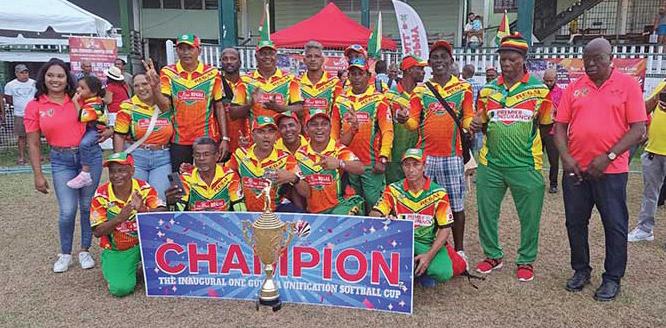
THE unavailability of grounds has forced the Georgetown Softball Cricket League (GSCL) Inc. to reschedule the Unity Softball Cup.
Originally set for this month end, the GSCL, in a release, pointed out that the three-day tournament will now be played on November 14-16. However, the women’s category, which will be played on a knockout basis, will commence on Thursday, November 13. The GSCL Inc. pointed out that it apologises for the inconvenience caused and looks forward to the teams’ participation on the new dates mentioned.
The tournament is being held in keeping with the wishes of Ministers of Culture, Youth and Sport, Charles Ramson Jr. and Steven Jacobs, who delivered remarks at the inaugural One Unification softball tournament, urging the GSCL to ensure they make full use of the four new stadiums across the country which are due to be officially opened later this year.
Minister Ramson had also urged the tournament’s organisers and players to consider rotating their tournaments around the country in order to broaden the reach and impact.
Following closely on the successful staging of the recent One Guyana Unification extravaganza, held in conjunction with the Ministry of Culture, Youth & Sport, the
GSCL is leaving no stone unturned to keep the grassroot game alive.
According to the organisers, this tournament is being used “to bring our people together through sports and by extension the grassroot game.”
This tournament will however be played with a difference with matches scheduled to be played in all three counties – Demerara, Essequibo and Berbice - with the Open set for grounds across the ancient county, the Masters Over-40 in Essequibo and the Legends Ove-50 in Demerara. In addition, the women’s category will be played in Georgetown.
The action culminates at the Police Sports Club ground on the final day with the finals in all four categories.
The winners of all three men’s categories are guaranteed $500, 000 while the runners-up will take home $100, 000. Other incentives will also be up for grabs, with the Most Valuable Player (MVP) in each category, including the women, riding off with a motorcycle. The winners of the women’s category will be awarded $200, 000 and the losers $100, 000.
Registration is ongoing and interested teams are asked to contact 219-041 or 7460090. Meanwhile, teams in Berbice are asked to contact Ganesh Balgobin on 642-9893 and for Essequibo, Patrick Rooplall on 671-5697.

KINGSTON, Jamaica, (CMC) –Reggae Boyz head coach, Steve McClaren has credited the chemistry within the team for his side’s dominant 4-0 thrashing of Bermuda in their CONCACAF World Cup Qualifying match on Tuesday.
Jamaica was led by strikes from Bobby De Cordova-Reid, Shamar Nicholson and Dujuan Richards, along with an own goal, while Renaldo Cephas provided two assists that earned them an important win and sent them to the top of Group B on nine points.
While he did not get on the scoresheet, Kaheim Dixon was a constant threat for Jamaica on the night.
Speaking following his side’s third win of the campaign, McClaren said the strong connection between his attackers made them a dangerous outfit.
“We said to the players that it’s nothing tactical about the way we play. It’s just pure energy we needed, and Kaheim gives us that.
“Cephas was different. He started the other two games, and now we got Shamar Nicholson, and everybody knows what Shamar Nicholson can do,” McClaren said.
“I thought the chemistry was excellent. We needed energy after Curaçao, and Kaheim and Shamar came on [in that game]
and when they came in, they were a real handful, and Cephas was always a threat. He is now playing first-team football regularly and you can see that.
“[Bailey] Cadamarteri and Tyreece Campbell played 60 minutes [against Curaçao]. Kaheim and Shamar played 30, so I just flipped it and reversed it. I wanted the energy from the beginning, and to carry the energy through,” he added.
Nicholson, who with seven goals in 13 matches in the qualifying campaign is Jamaica’s top goal scorer, had struggled in recent matches and looked uncertain in front of goal.
However, he justified McClaren’s to decision to start him by scoring the third goal.
“He had a great effect on the game. He helped not just in his effect on the game individually, he helped the team in terms of how he pressed, because it is difficult for a nine, when you are the first man pressing. But he did very well. His work rate, how he held the ball up, and he was always a threat in the box,” McClaren admitted.
With Leon Bailey and Demarai Gray set to return for the final two matches in November, McClaren said competition for places was much closer than it was a year ago when he took charge of the team.
ST. GEORGE’S, Grenada, (CMC) –IN a pivotal step towards the ICC Men’s Under-19 World Cup, Cricket West Indies (CWI) has announced a seven-match Youth ODI series against England U-19s, set for Grenada this November.
The high-stakes contest, running from November 16 to December 1 at the Grenada National Stadium, will serve as a critical testing ground for the young Windies squad. The series was relocated from its originally intended venue in St. Vincent after the National Sports Council there confirmed the
grounds were unavailable due to international scheduling.
This tour comes on the heels of the West Indies’ hard-fought 4-3 series victory over Sri Lanka U-19s in Antigua, providing the team with valuable momentum.
CWI Director of Cricket, Miles Bascombe, emphasised the strategic importance of the upcoming fixtures. “This series against England forms an important part of our strategic plan to refine the squad through consistent, high-quality competition,” Bascombe stated.
“The group has already gained valuable experience and confidence from the recent win against Sri Lanka, and this next assignment provides another crucial opportunity for growth,” he added.
“We expect another highly competitive contest in Grenada. These matches are vital in ensuring our players continue to develop their skills, temperament, and match awareness.”
Both teams will arrive in Grenada on November 8 for an intensive preparation period. They will have three days of training at the
stadium before England faces a Grenadian Under-25 select XI in a warm-up match on November 12.
The full series schedule is as follows (all matches at Grenada National Stadium):
MIRPUR, Bangladesh, (CMC)– Rishad Hossain produced a mesmerising spell of spin bowling which crippled the West Indies and propelled Bangladesh to an impressive 74-run victory in the opening One Day International here on Saturday.
The leg spinner grabbed a maiden five-wicket haul, as the West Indies, after a promising start, were bundled out for 133 in 39 overs in pursuit of the home side’s total of 207 in 49.4 overs at the Shere Bangla National Stadium.
While batting last was always expected to be tricky on a pitch that offered plenty of turn for the spinners, the West Indies seemed on track to register a comfortable victory following a promising start by openers Brandon King and Alick Athanaze.
The pair started cautiously, with the first two overs bowled by pacer Taskin Ahmed and left-arm spinner Tanvir Islam, respectively, being maidens.
But King hit Taskin for a four and a six in the third over of the innings and Athanaze swept Islam for three fours and hit him for a six over long on in the ensuing over to
see the West Indies race to 28 without loss after four overs. Athanaze brought up the 50 for the West Indies in the 12th over, but it didn’t take long for Player-of-the-Match Hossain to unleash his carnage.
He began by trapping Athanaze lbw for 27 to give the home side a much-needed breakthrough.
King and Keacy Carty then shared a 28-run partnership that left the Windies comfortably positioned at 79 for one in the 20th over.
But Carty never looked settled, and it came as no surprise when he edged Hossain to slip as he tried to break the shackles with a big shot.
King looked on course for a half cen tury until he was bamboozled by a delivery from Hossain that spun across his body and grazed the outside edge on its way through to the wicketkeeper to be out for 44, as the Windies slipped to 82 for three.

Three deliveries later and without a run added, Hossain had Sherfane Rutherford

DUBAI, United Arab Emirates, (CMC) – Nepal, Oman and the United Arab Emirates(UAE) are the final three teams to book their spots in next year’s ICC Men’s T20 World Cup.
The trio qualified for the tournament through the Asia/East Asia-Pacific Qualifier, which concluded earlier this week. With their qualifications, all 20 teams for the 2026 ICC T20 World Cup, which will be held in India and Sri Lanka from February 7 to March 8, have been confirmed.
Hossain then captured his first five-wicket haul in international cricket when he had Roston Chase caught behind for six to leave the visitors tottering on 92 for five. • Continues on Page 26
By Sean Devers
DESPITE steaming hot conditions at Lusignan yesterday the final preliminary round GCB’s Queensway Security Inter-County Super50 between Essequibo and the Select X1 was delayed for 90 minutes due to wet spot on the pitch resulting in the contest being reduced to 45 overs per side.
Watched by a fair size crowd the Select X1, strengthened by the inclusion of Test opener Tagenarine Chanderpaul who recently returned from India, were decimated for 69 in 30.3 overs.
The left-handed batter, one of three Guyanese who returned from the two-Test series which West Indies lost 2-nil, again failed, being trapped LBW by fast bowler Ronsford Beaton for one in the third over.
The select X1 never recovered as only Bartician Renaldo Jeffery who hit two fours in 22 and Afraz Budhoo (12) reached double
figures. Antony Adams grabbed 4-27 and got support from Beaton (2-9) and Ricardo Adams (2-16) for Essequibo who galloped to 70-0 in just 7.2 overs to win by 10 wickets and qualify for next Sunday’s final.
The 32-year-old Boodie, who scored the only Senior Inter County double Century in 2014 against the National U-19 team, finished undefeated on 54 from 33 balls with five fours and four sixes. Kanhaiya Ramkarran played the role of silent partner, ending on 14 not out with two fours.
Boodie played his only Regional 50over match in 2016 when he made six as Assad Fudadin’s unbeaten 103 give Guyana a five-wicket win against CCC and is a contender for an opening spot for the 2025 Regional Super50 from November 19-29 in Trinidad.
Earlier, the 29-year-old Chanderpaul, who managed just 52 from four innings in India missed one on the stumps from Beaton and the ball crashed into his pads at 2-1.
Beaton, working good pace on a flat track removed Romeo Deonarain (1) and the select X1 were 5-2.
After Budhoo fell to Ricardo Adams at 23-3, Kwesi Mickel (1) was run out, Antony Adams had Brandon Jaikarran (8) stumped, Ricardo dismissed Carlos LaRose (3) and Antony Adams bowled Romario Ramdeholl (0) on 33-7 as five wickets tumbled for 10 runs.
Antony Adams had Aryan Persaud (7) LBW at 52-8 before Jeffery (22) was stumped off Antony Adams and Joshua Jones (9) was stumped off Myhiem Khan.
Essequibo played three matches and won two of them to reach 23 points.
The team from Guyana’s largest County has 15 Bonus points with NRR of 1.776 to secure a place in next Sunday’s final.
Defending Champions Demerara (17 points) will face-off with hosts Berbice (12 points) from 09:00hrs at the 69 ground today in virtual Semi-final.
Italy is set to make its inaugural appearance at the tournament after they progressed via the European Qualifier alongside the Netherlands. India, the defending champions, and Sri Lanka qualified automatically by virtue of being hosts, while Australia, Bangladesh, Afghanistan, England, South Africa, USA and the West Indies punched their tickets after finishing in the top seven at the T20 World Cup in 2024. Pakistan, Ireland and New Zealand secured their berths via the ICC T20 rankings, while Canada, Italy, the Netherlands, Namibia, Zimbabwe, Nepal, Oman and the UAE qualified for the showpiece through the regional qualifying tournaments. The 2026 tournament will be played using the same format as the 2024 event, with the 20 teams placed into four different groups of five sides ahead of the Super Eights phase that will include the top two finishers from each group. The Super Eights will feature two groups of four sides, with the top two finishers from each group then progressing to the knockout semi-finals.
